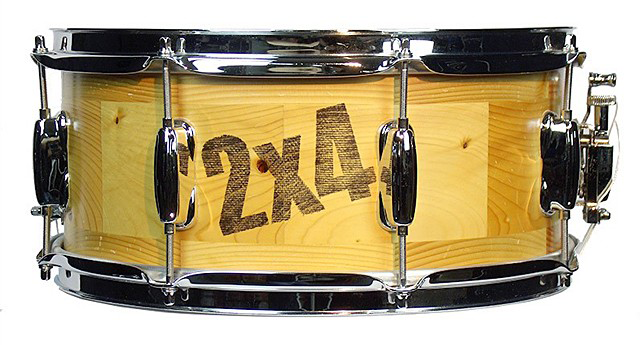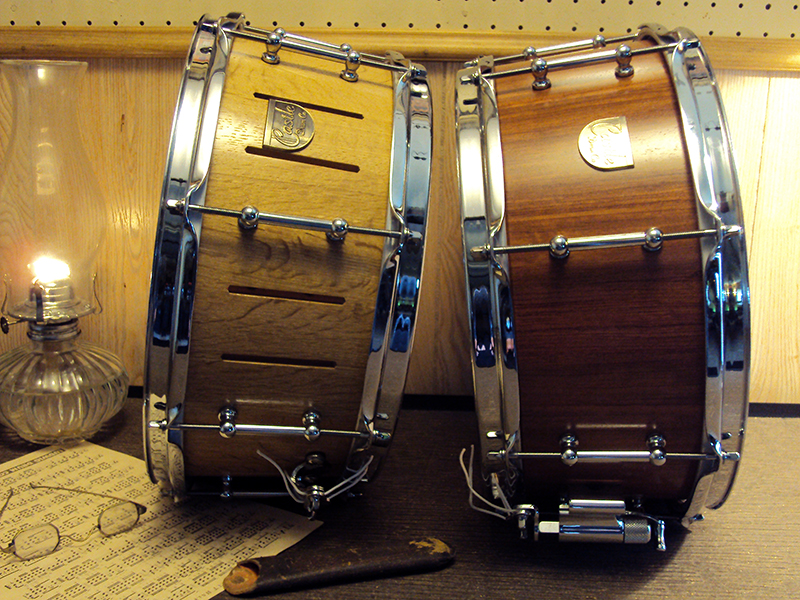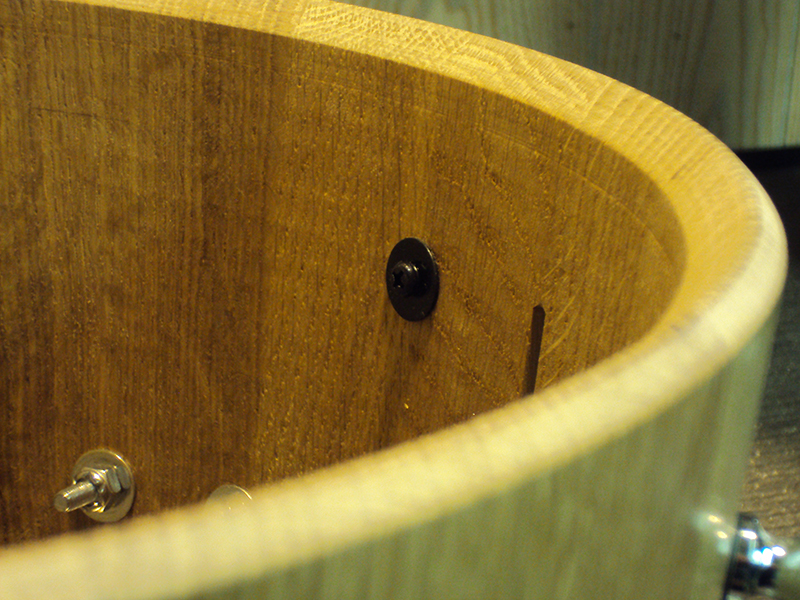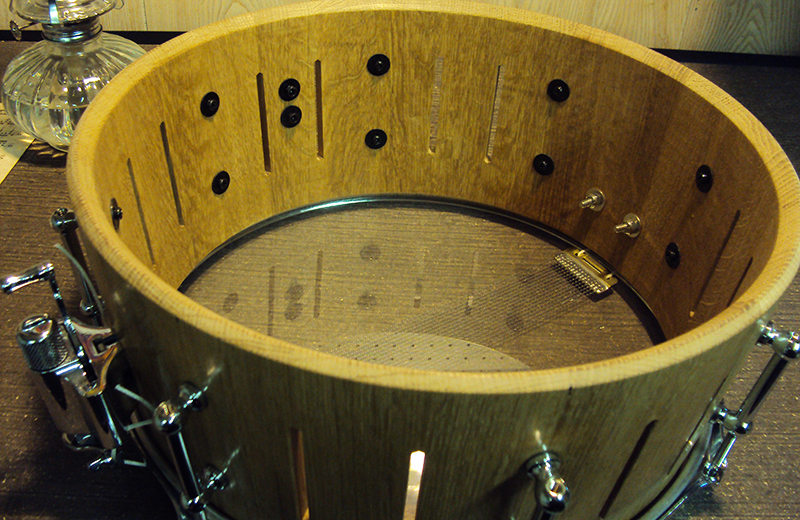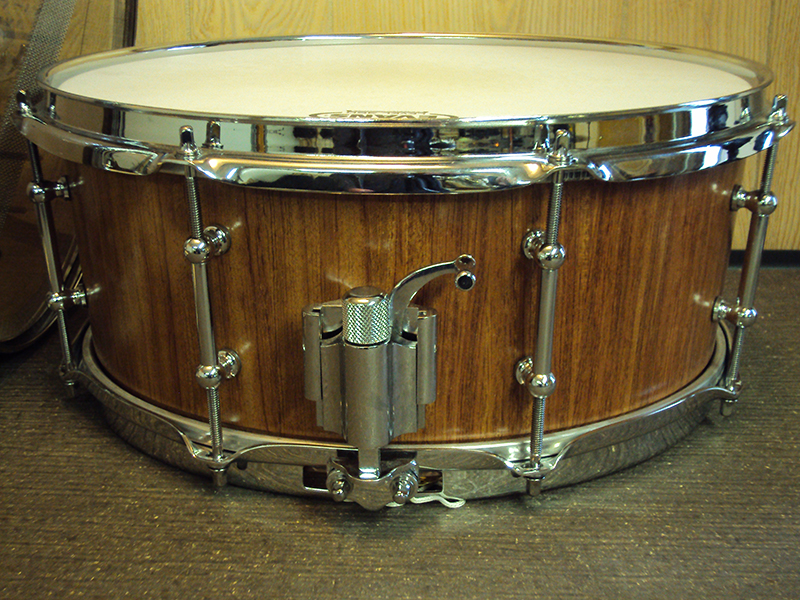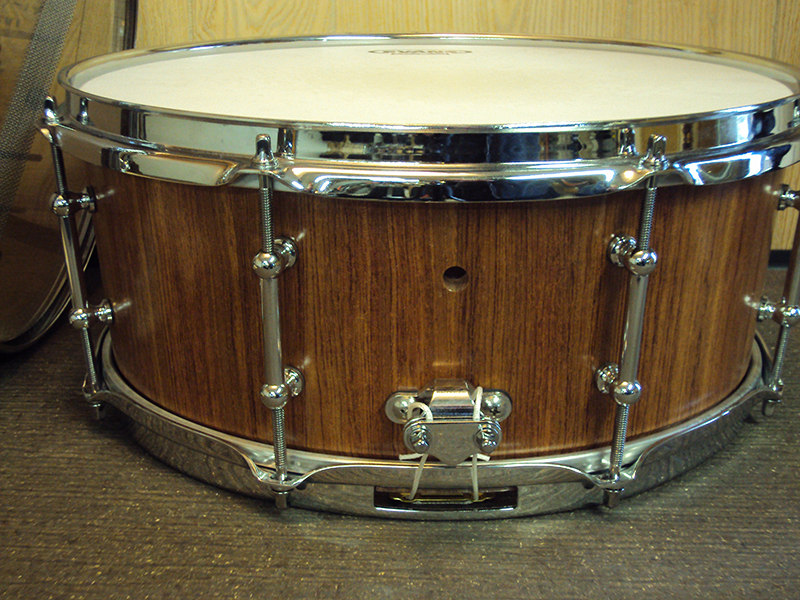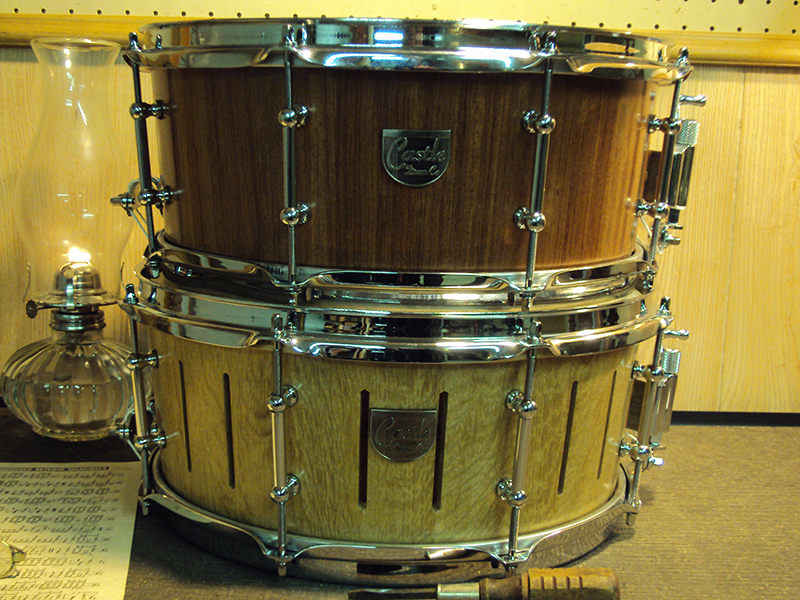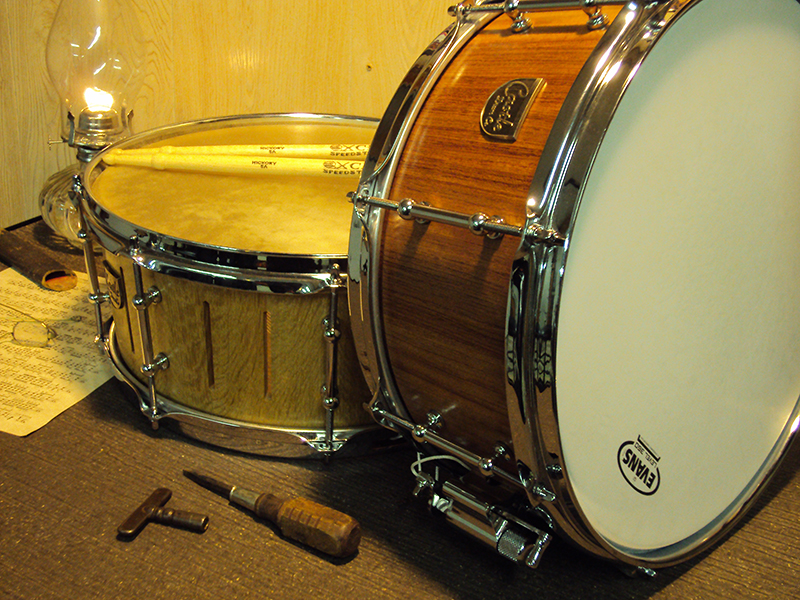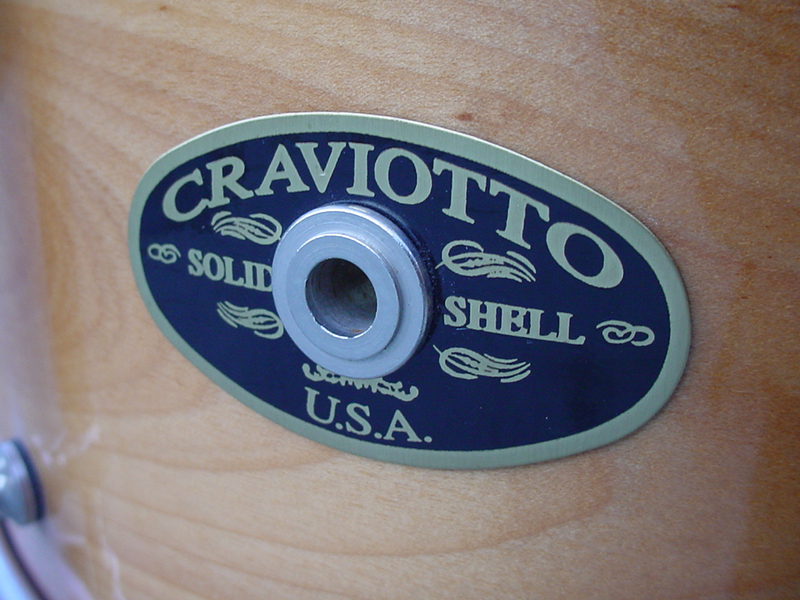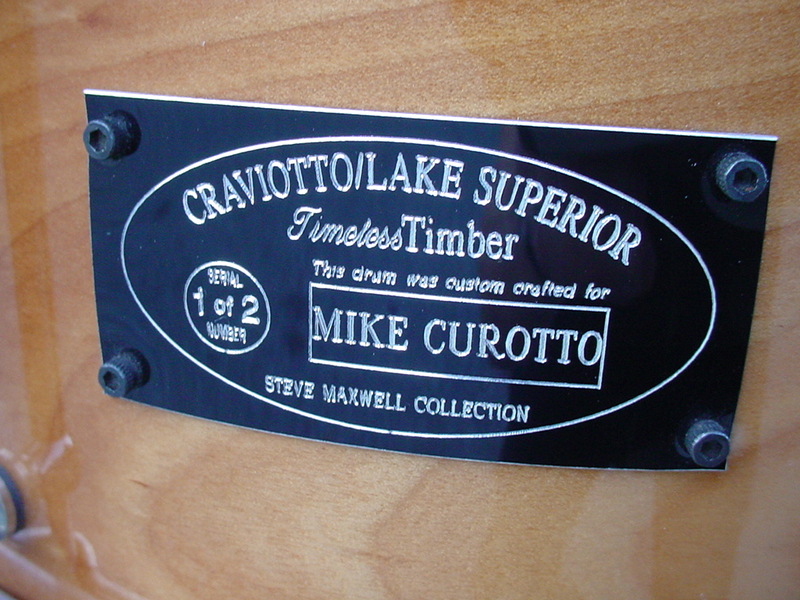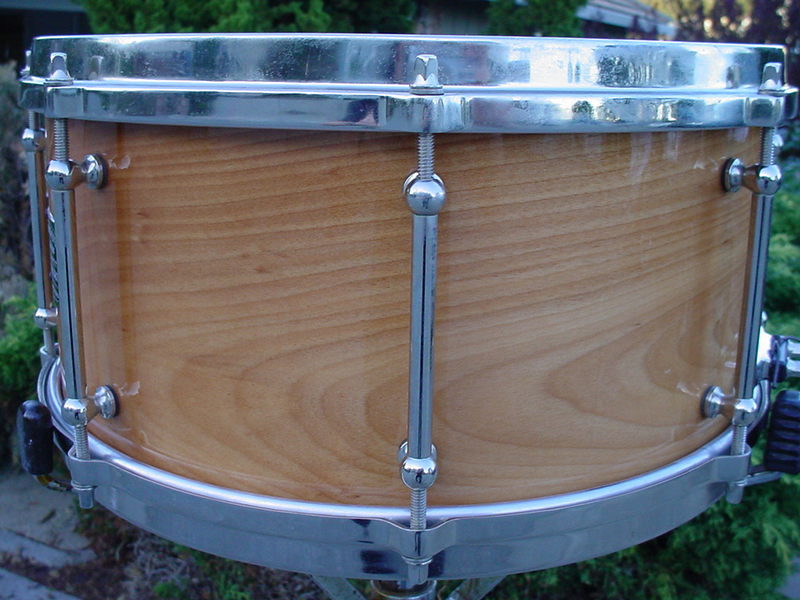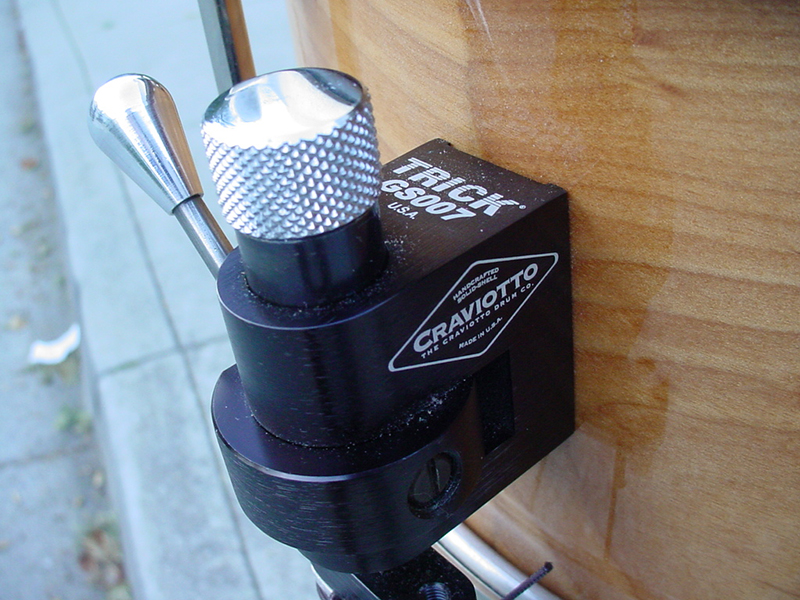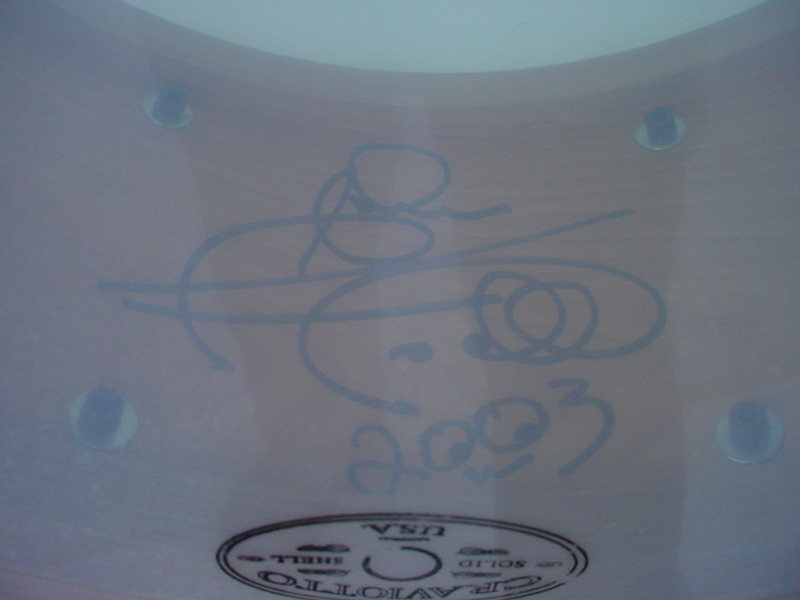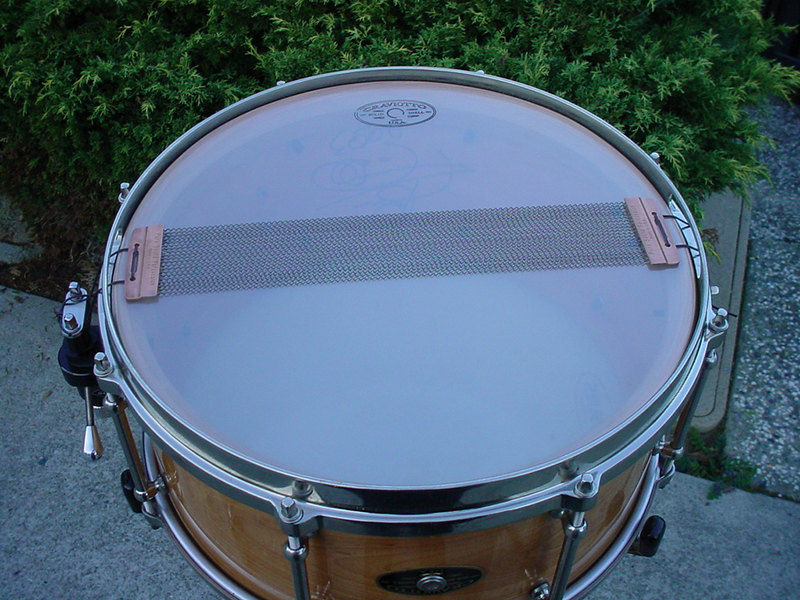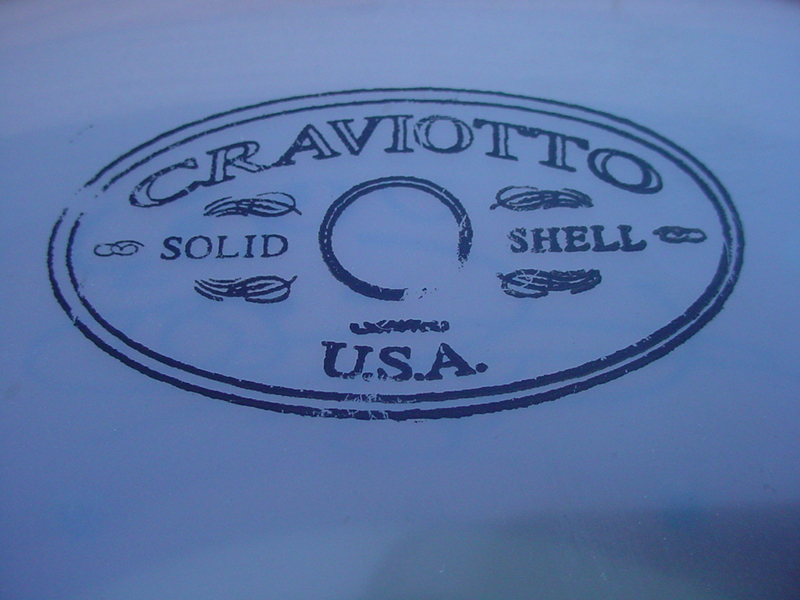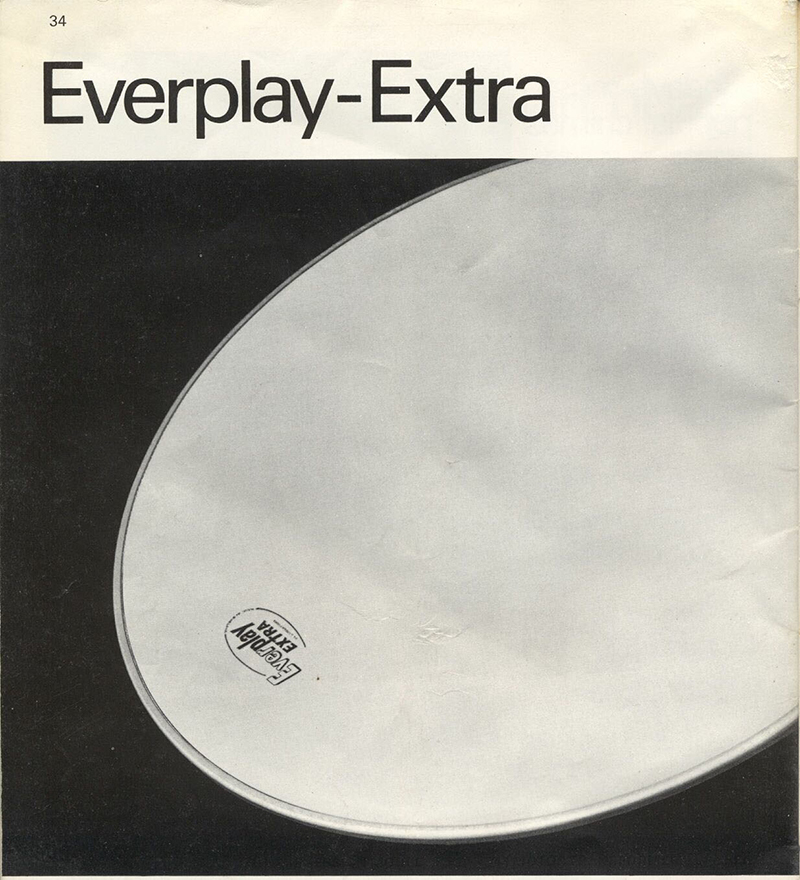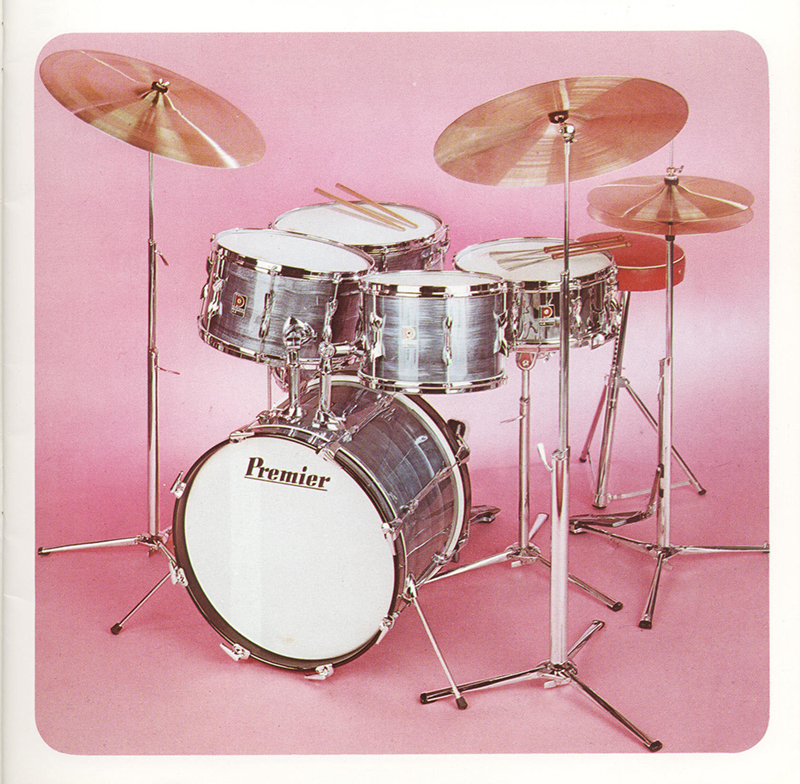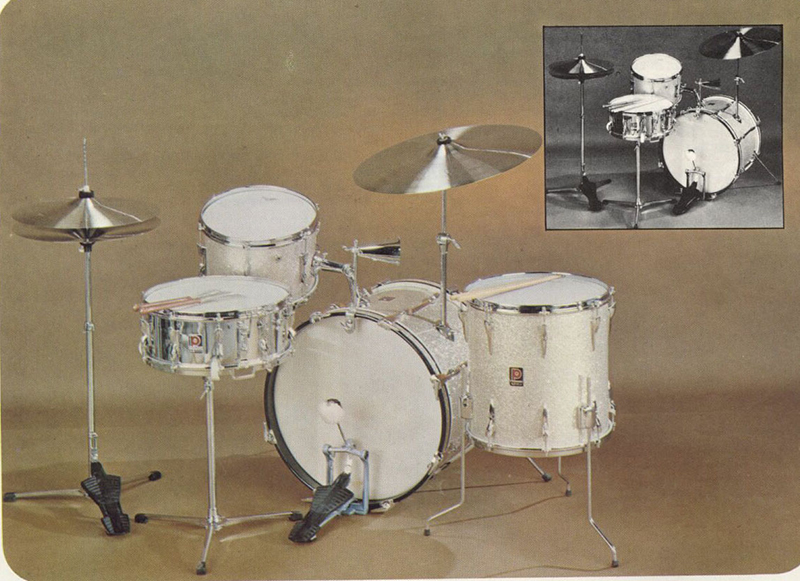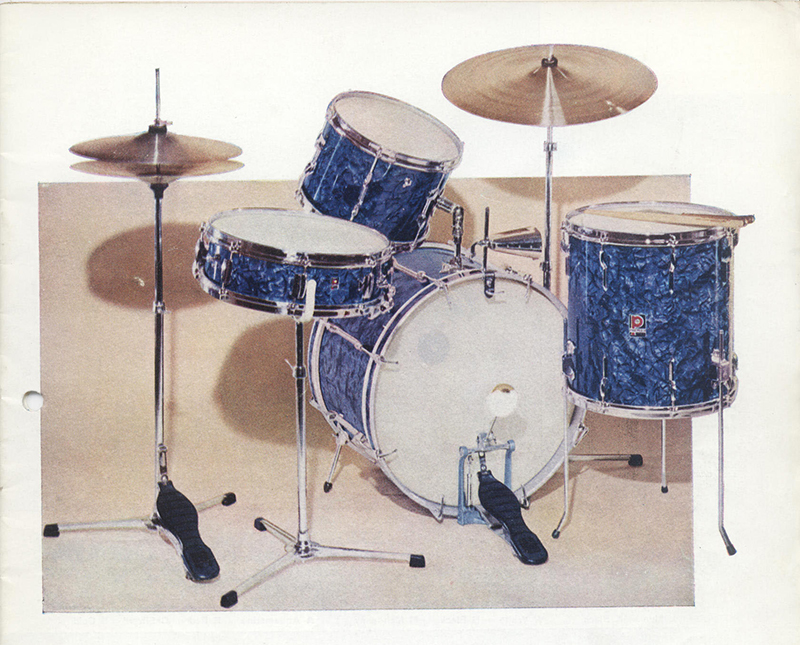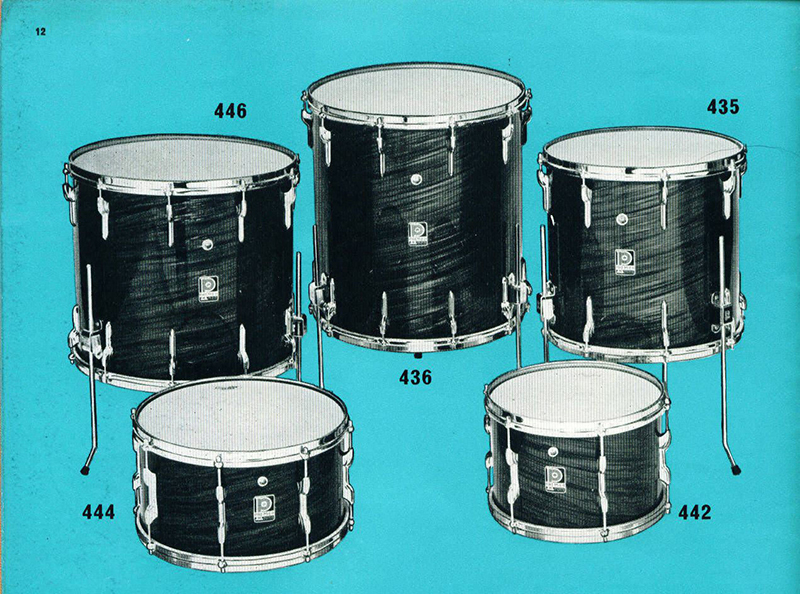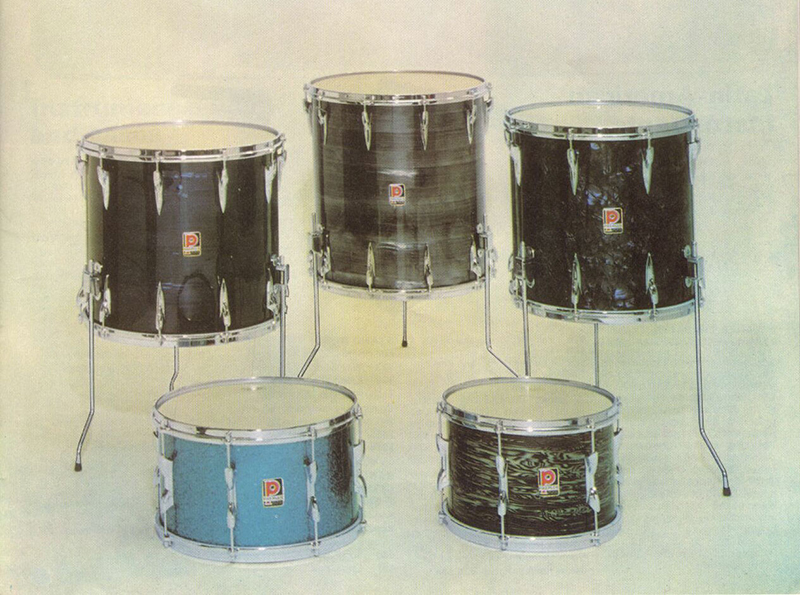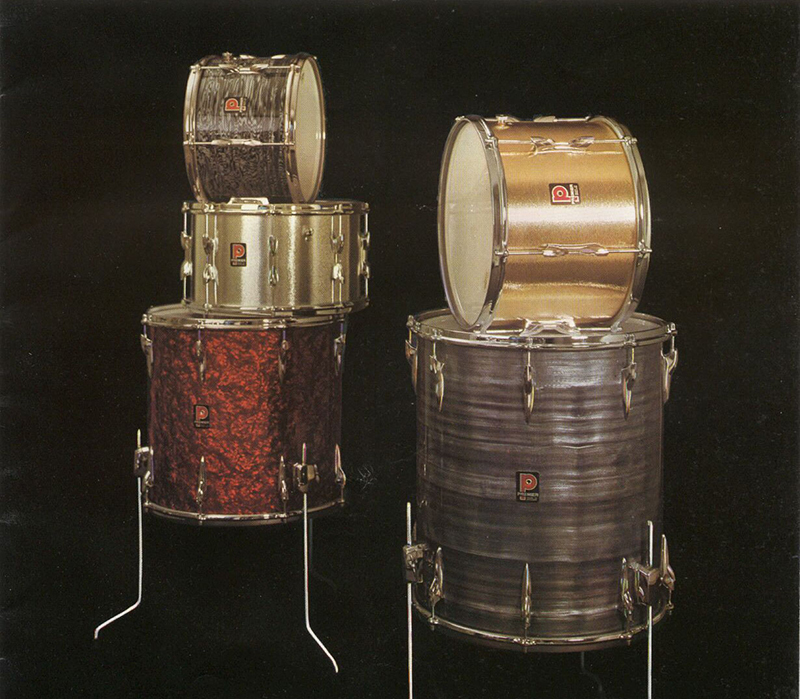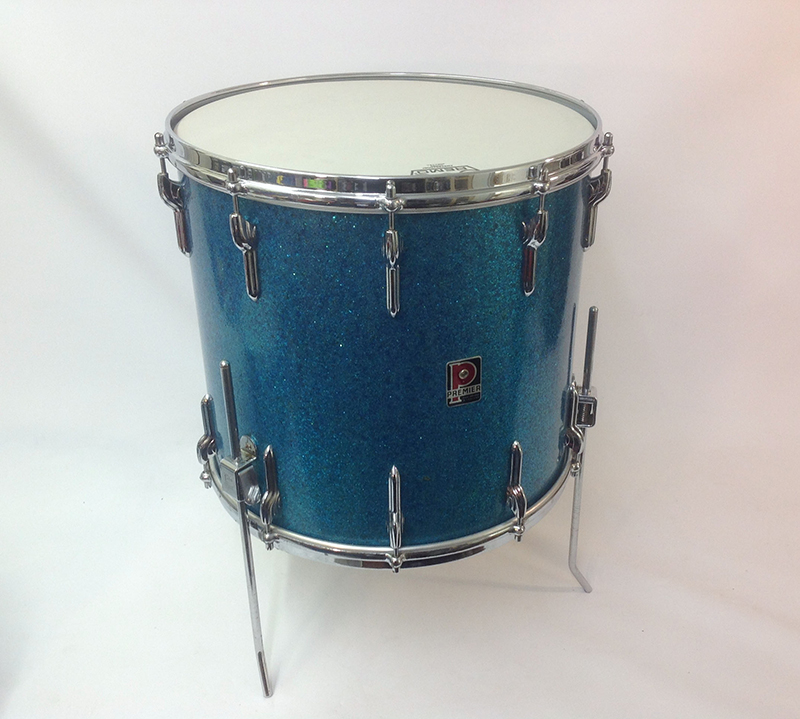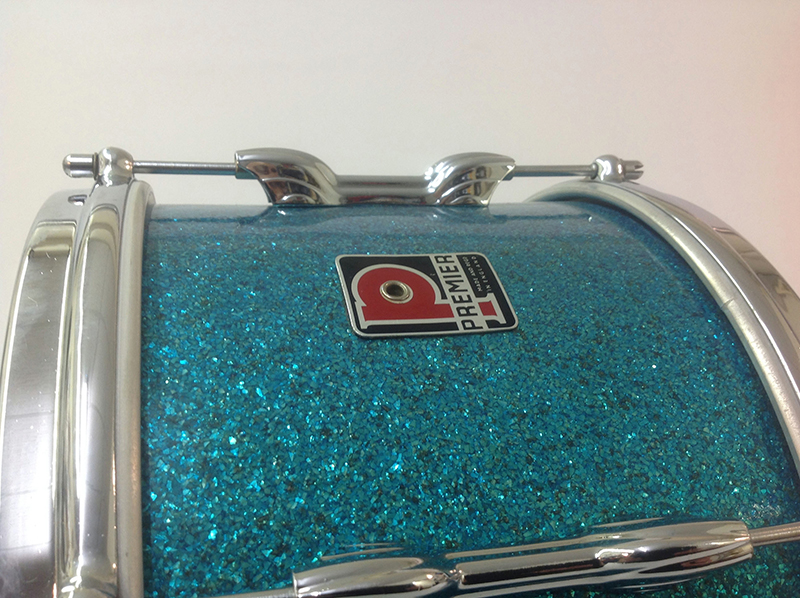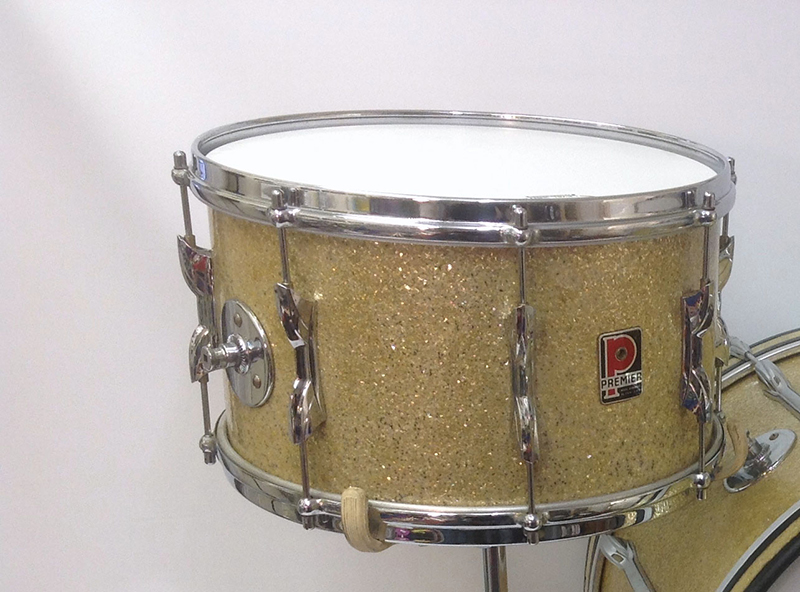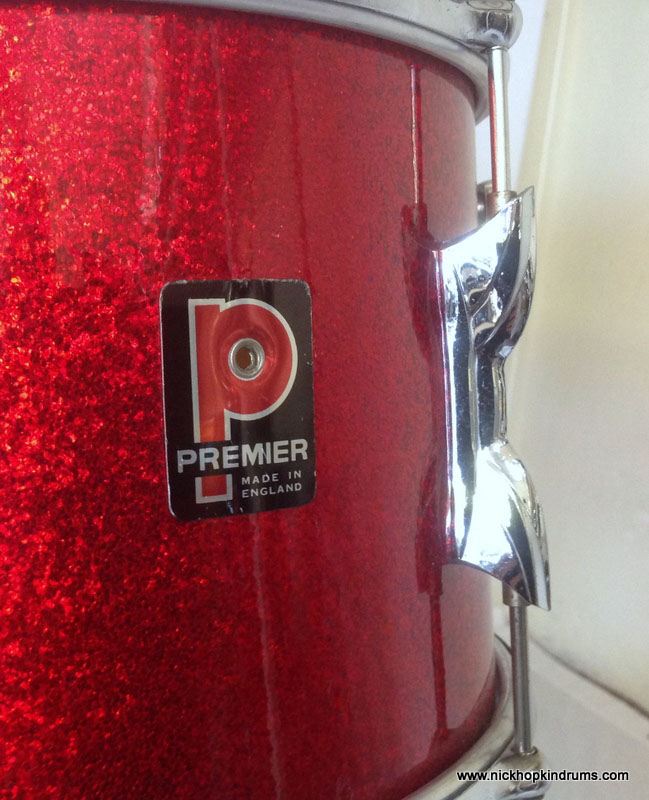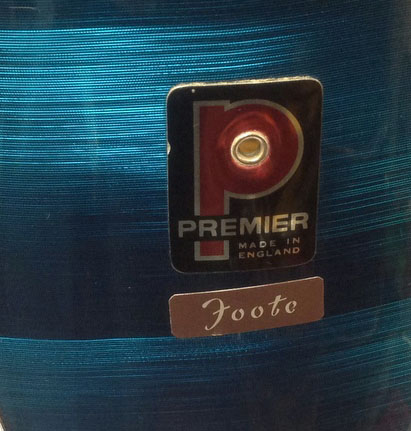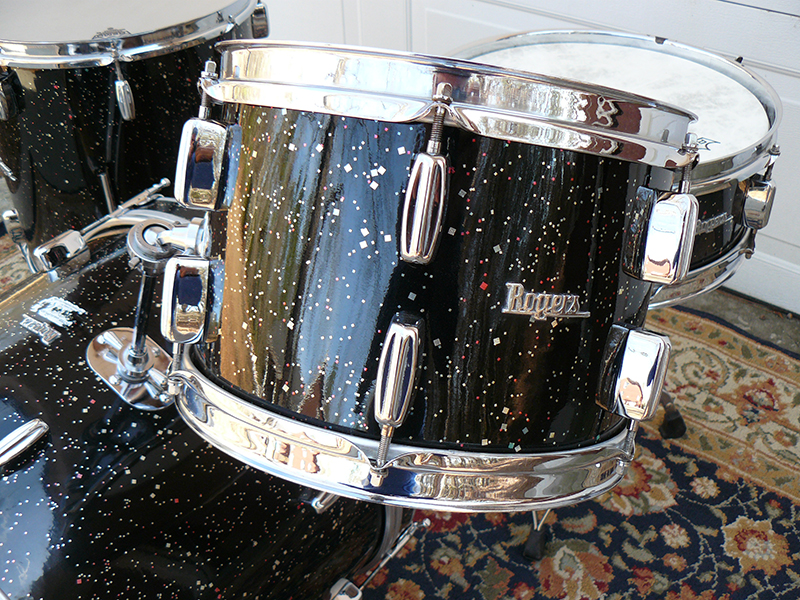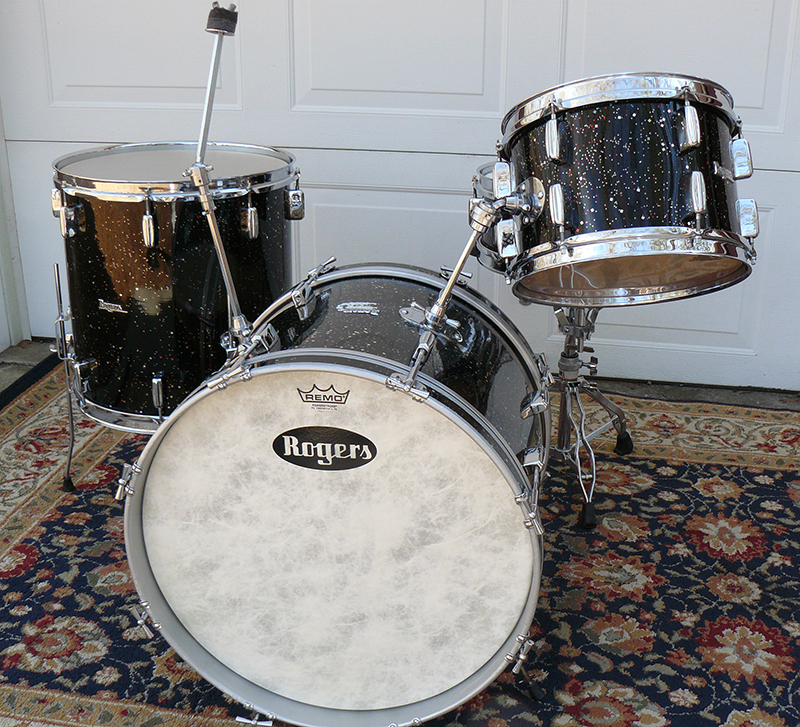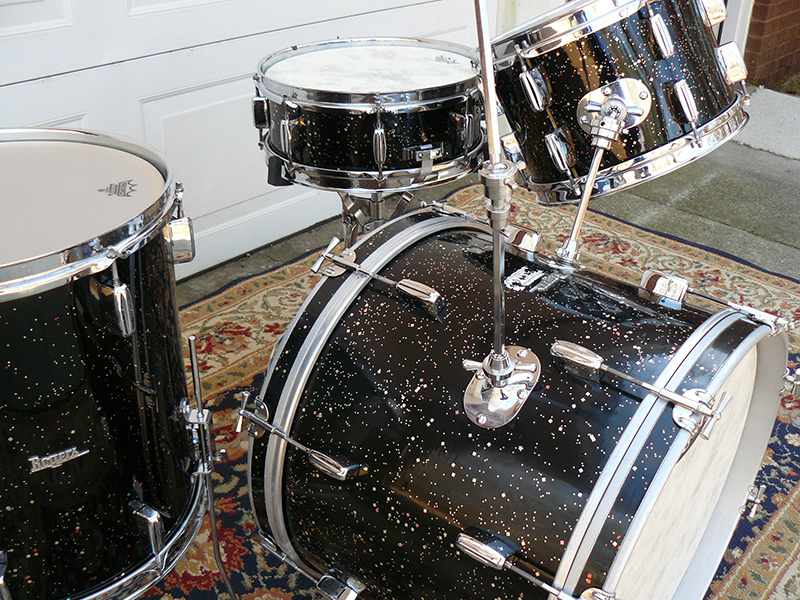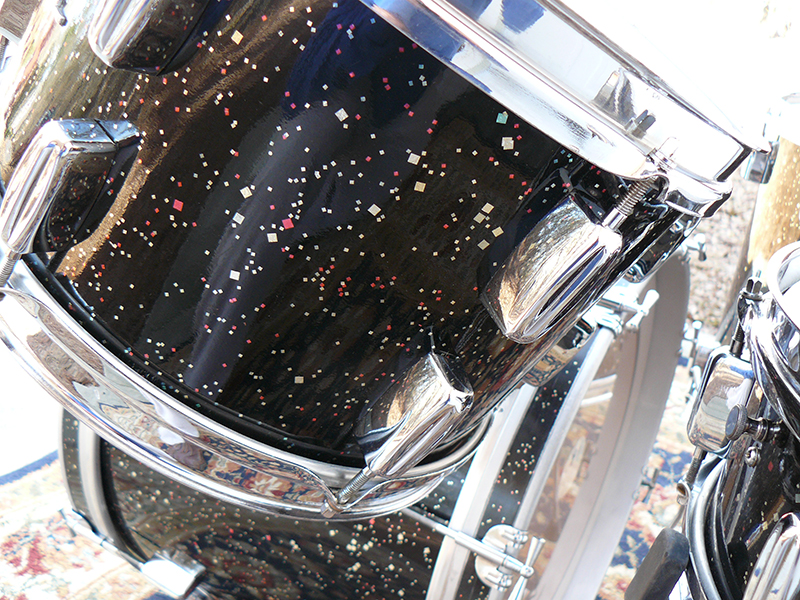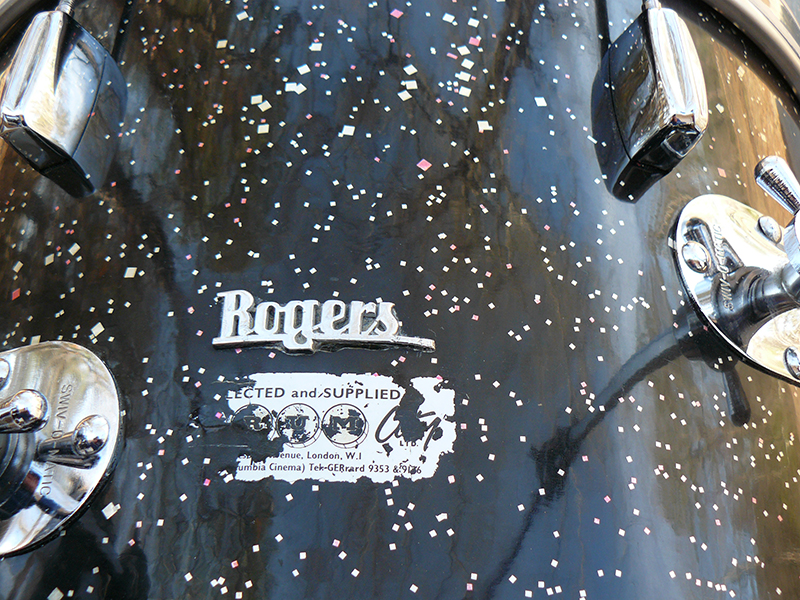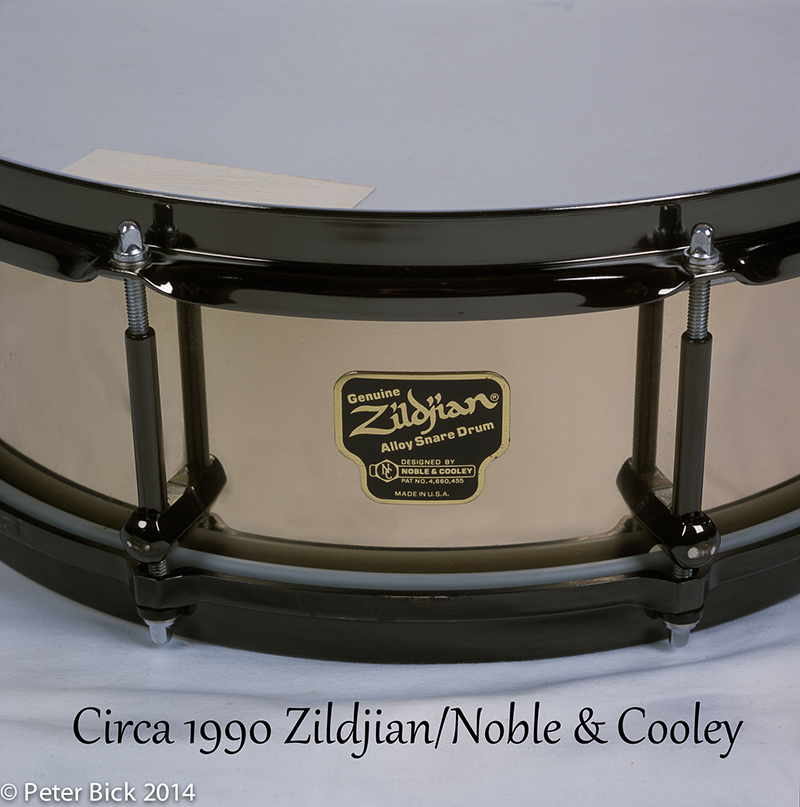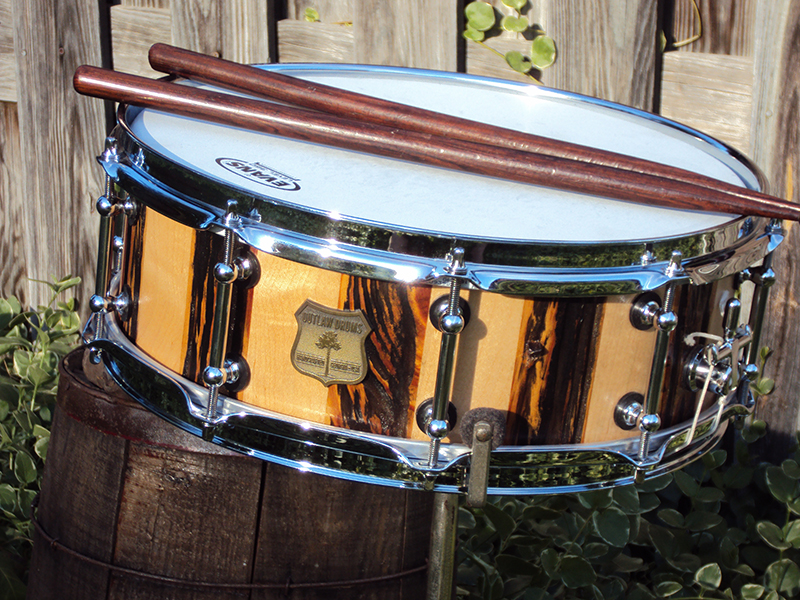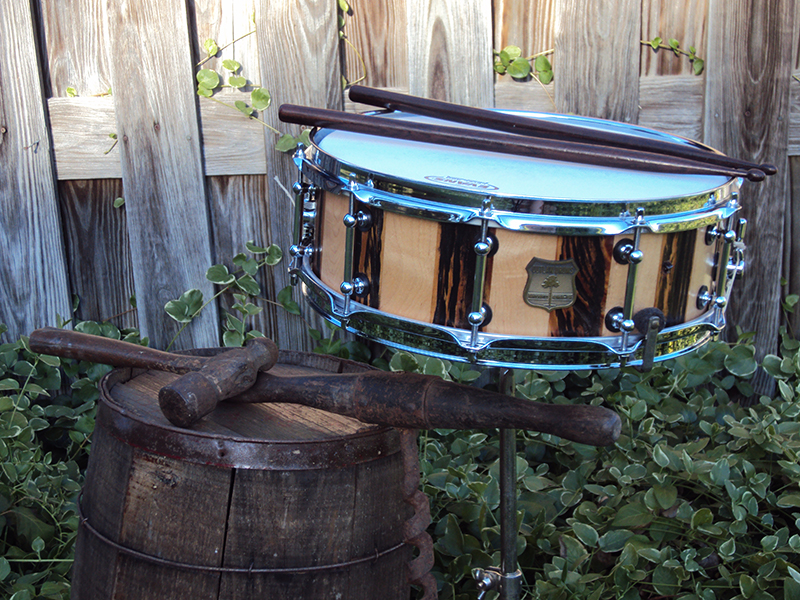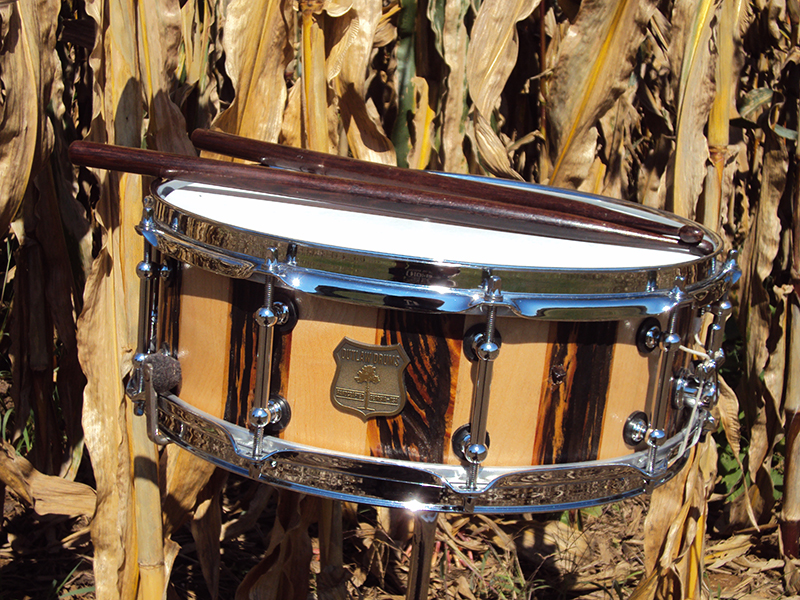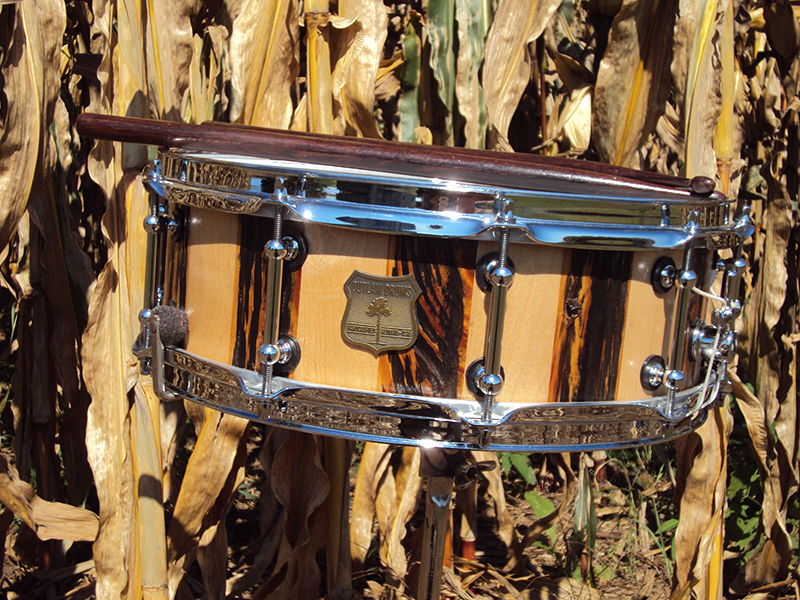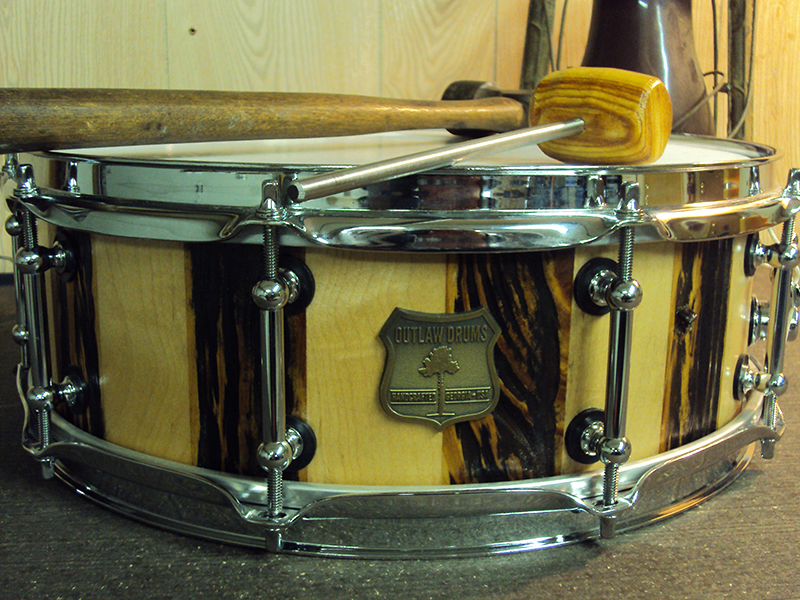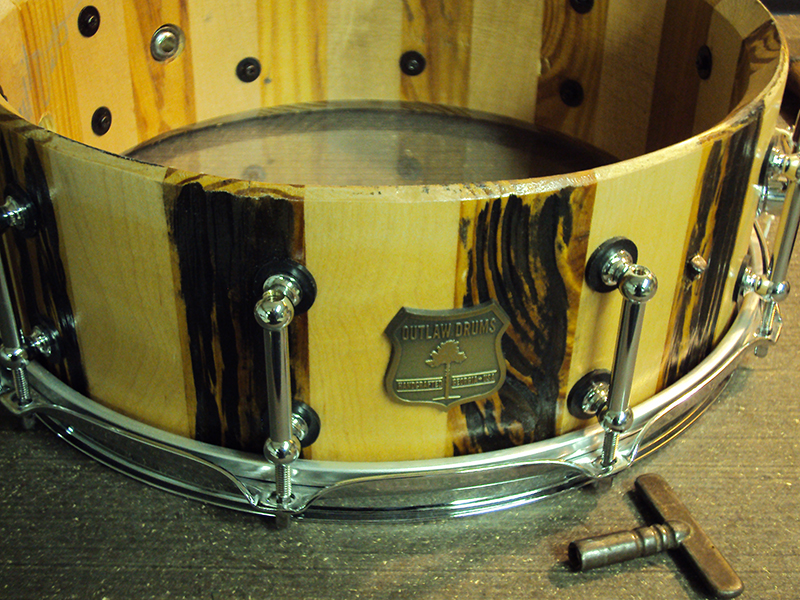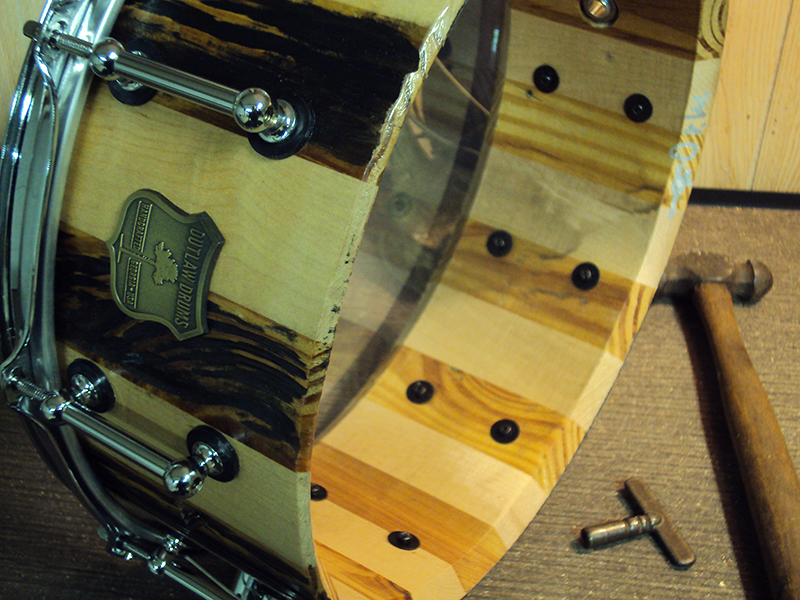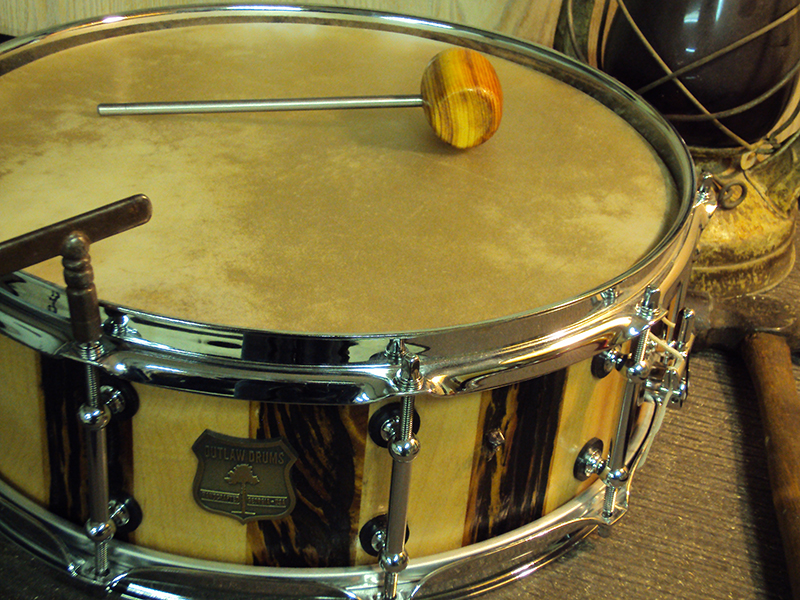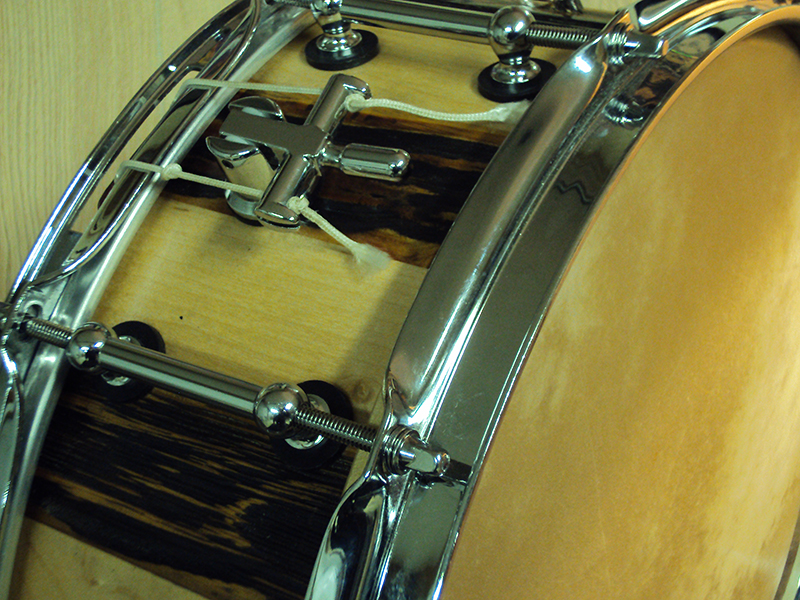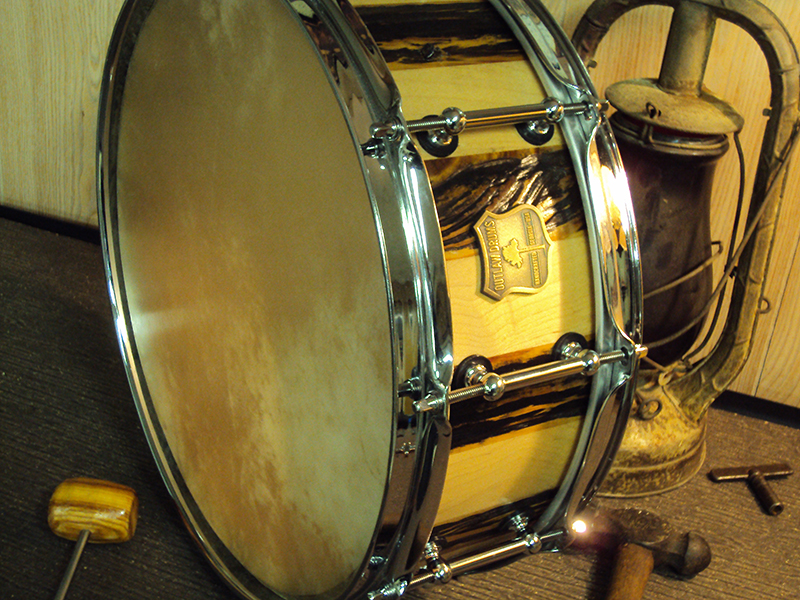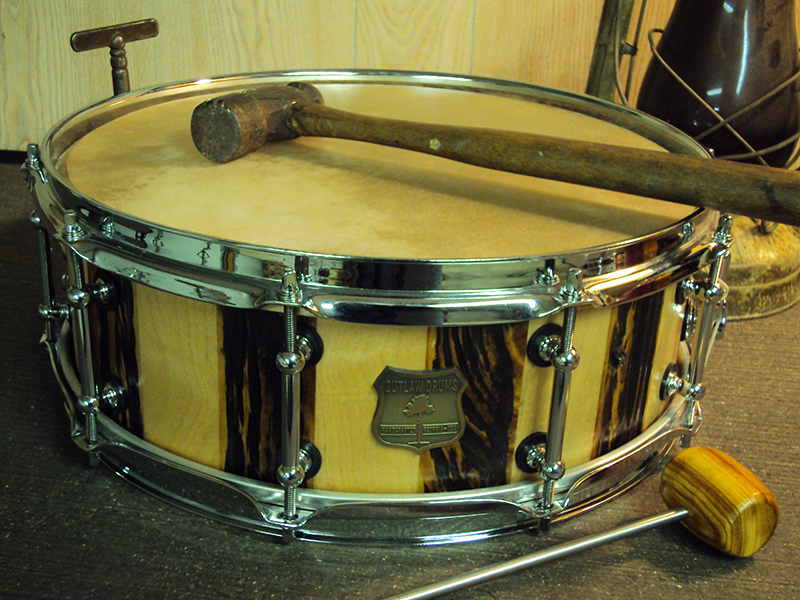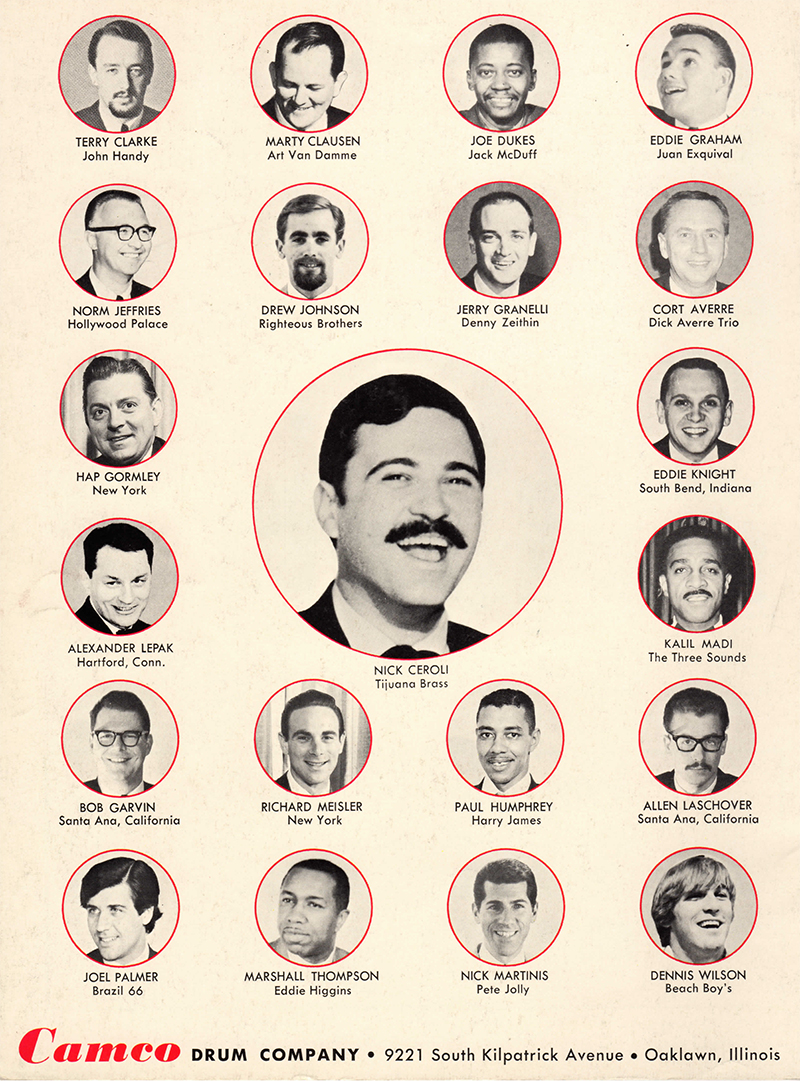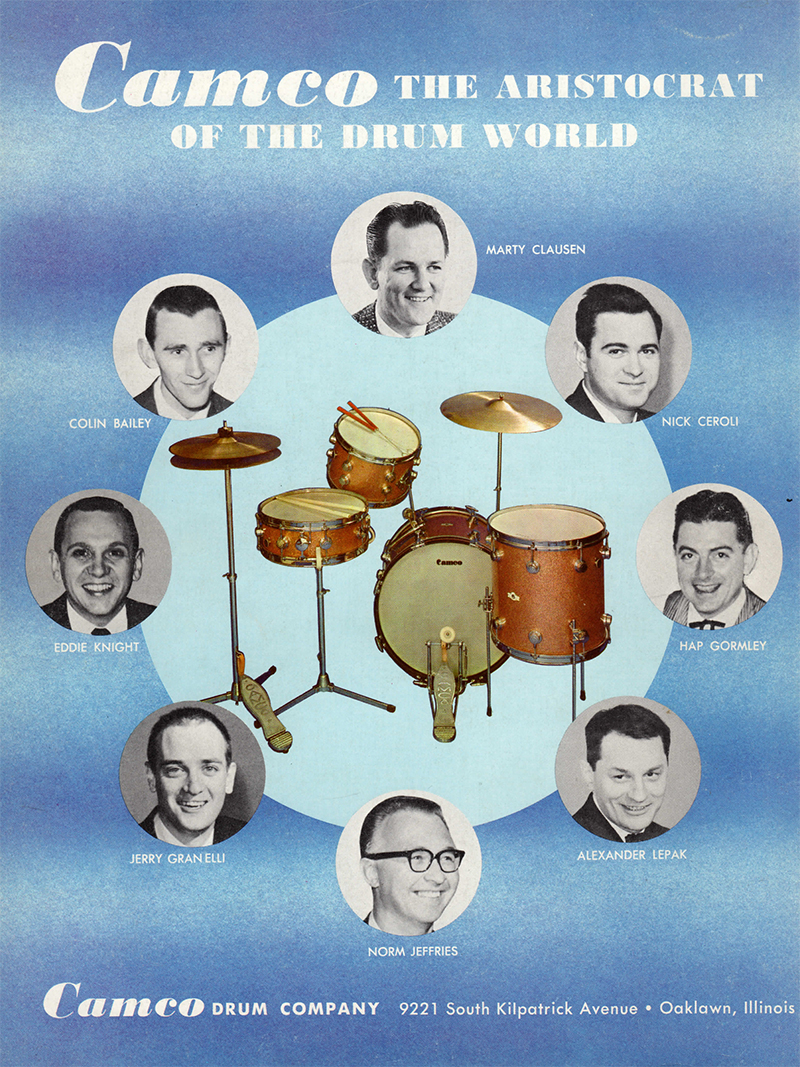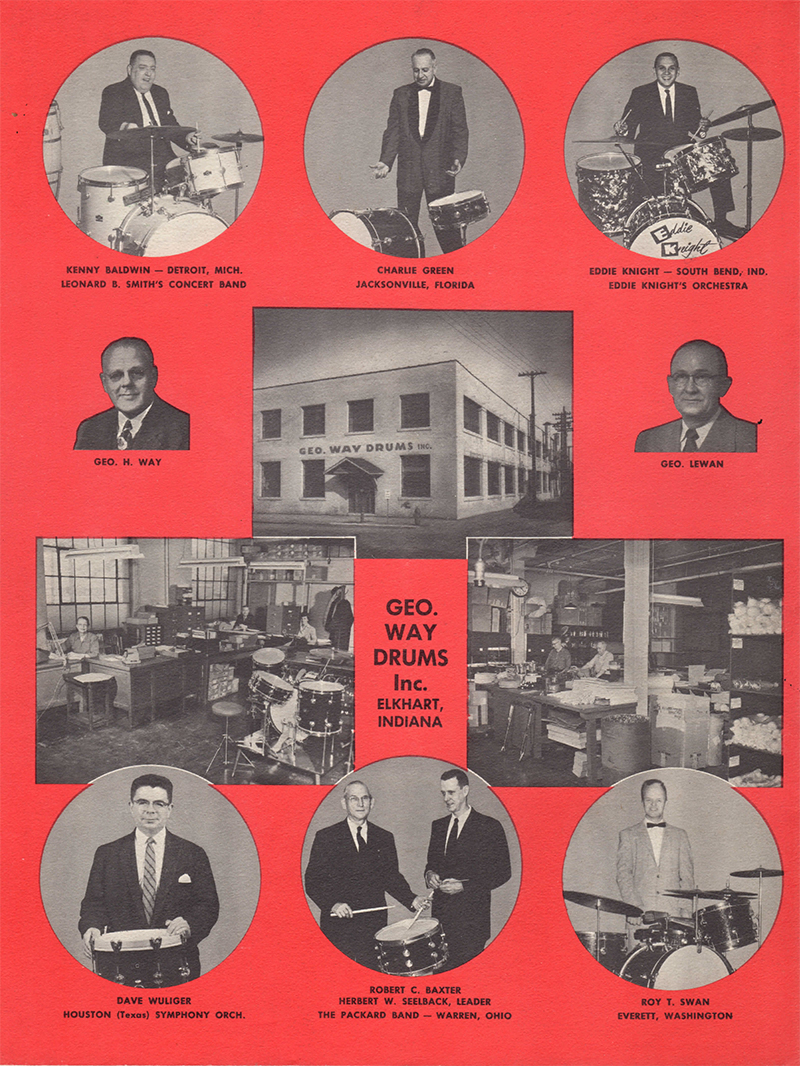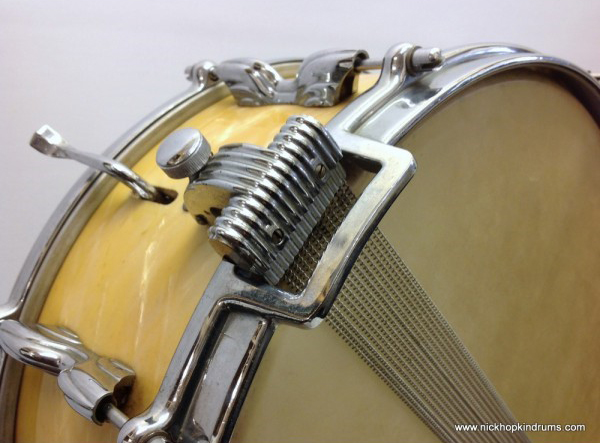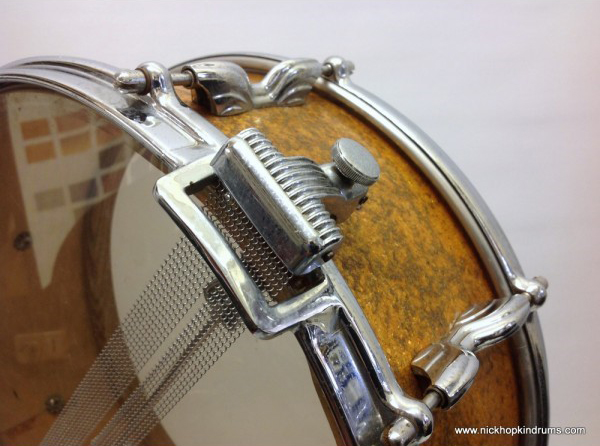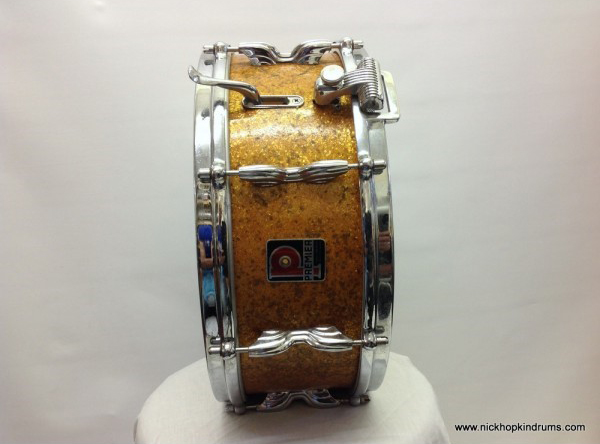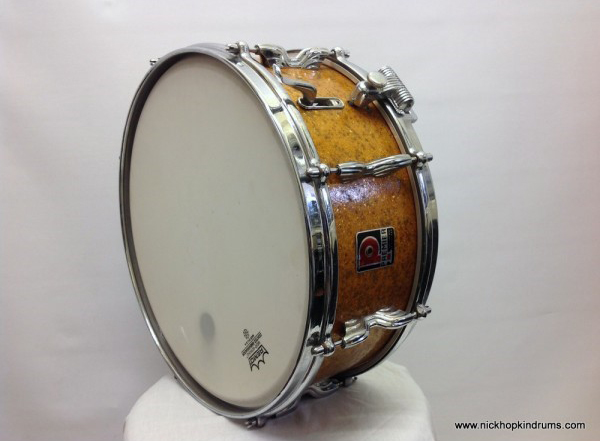Ah, cold, cold, cold, February! You make us want to stay inside and obsess over our vintage drums! Not much to report from the Eastern front but these few tidbits-
Read more2x4 Famous Snare Drum
Famous Drums' "2x4" Custom Snare Drum
Put the Drums in the Organ, Please...
1932-34 Slingerland 5x14 Artist DuAll Model (“Pulley” Version)
By Mike Curotto
Hi All,
A few years ago I was contacted by drummer/educator Ed Soph who wanted some information about this drum. I told him what I knew and after a few months I was able to purchase the drum from Ed. Over the years I have discovered three versions of the Slingerland DuAll mechanism: 1. A center post very similar to if not a direct copy of the Super-Ludwig center post (usually equipped with a Tone Flange). 2. An interior “pulley” type mechanism instead of a center post (no Tone Flange). 3. No center post and no “pulley” mechanism (no Tone Flange). This snare drum has the “pulley” mechanism
The Shell: Green Sparkle from the 1930s is notorious for having black “cancer” spots. Fortunately this drum is cancer free. The finish had the normal years of accumulated schmutz but everything cleaned up and polished up nicely. The interior of the solid maple shell was very clean with no re-ring separation other than a 2” section, no big deal. The shell has normal bearing edges top (no Tone Flange) and bottom . The cloud badge is very clean with a tight grommet. Lastly, a nice factory pre-assembly artifact was found on the interior of the shell...”Nickle DuAll”.
The Hardware: The nickel hardware was in great shape and was very easy to clean and polish. There were a few errant tension rods but I had the era-correct replacements in my parts stash.
The internal DuAll “pulley” mechanism is clean, well built and looks kind of artsy. The mechanism is smooth, works well but is not as solid as the center pole version that brought on the patent lawsuit by Ludwig & Ludwig. I’ve included interior and exterior photos of this version of the DuAll mechanism. The reader will clearly see the similarities to the already patented L & L Super-Ludwig mechanism of the same era. The manufacturer’s cartouche markings on the snare gates are “L” and “LL”.
The Slingerland Artist DuAll Model was only in production for approximately two years and due to this very limited production run Slingerland DuAlls are extremely rare. As far as my snare drum collection goes, my un-scientific guesstimate based on the number of Slingerland DuAlls I own vs. the number of L & L Super-Ludwigs I own is about 15:1 meaning for every DuAll I own there are 15 Super-Ludwigs that I own. If we look at the more realistic bigger picture out there in the collecting world my guestimate is more like 100:1. That’s just my very un-scientific observation. As always, feel free to weigh-in on the subject as I look forward to your comments and added information.
A nice Frank’s Drum Shop calf batter head, Slingerland slunk head and the original snares rounded out this cleaning/restoration.
Enjoy! Mike Curotto
Neal Morse Band, featuring Mike Portnoy - Alive Again Tour
THE "ALIVE AGAIN" TOUR - FIRST STOP, NASHVILLE! The Neal Morse Band will be performing their much anticipated debut album, "The Grand Experiment." The band, featuring award-winning drummer Mike Portnoy, will play ONE NIGHT ONLY in Nashville at Rocketown - Saturday, February 21st!
The Neal Morse Band (feat. Mike Portnoy) Saturday, February 21 at 7:30 PM Rocketown (White Building) - Nashville, TN
TICKETS ARE AVAILABLE ONLINE ONLY AND WILL SELL OUT! Visit www.rocketown.com/events for tickets and more information.
The Neal Morse Band will be hitting the US, Canada and Europe for a winter tour in 2015 and the complete event listing can be found at www.radiantrecords.com.
Castle Drums
Growing up in the shop of a Master Craftsman and Industrial Arts teacher, my Dad taught me a lot about making and fixing things. I learned about metal, leather, printing, mechanical drawing, and woodworking, among many other things. But the most important thing he taught me was quality. While making my rounds at the Nashville Drum Show, I saw many drums that were made with top-notch quality. But even amongst all the quality instruments that were present, some stood out a little more than others.
As I approached the Castle Drum Company’s booth, I at first thought I needed to get more sleep because the drums seemed a bit skewed. Taking a closer look I realized that my vision was fine and the drums were indeed, a bit skewed. David Cheney, the Master Craftsman behind Castle Drums, had come up with something special and a bit different. David had spent over a quarter of a century in fine woodworking as a maker of cabinets, building case work and furniture. Working with odd shaped and intricate pieces, his ability dictated a higher level of thinking about wood and the possibilities therein.
As many of us find as we become older and more proficient in life, we tend to start to figure out what we like and how we want to spend our time. David decided at one point that combining his love of woodworking and drumming might pacify that angst. After all, drums certainly can be made of wood. The one thing that he knew was that he did not want to be just another guy out there painting and assembling drums: he wanted to set himself apart from the rest of the herd. For that, David would have to dare to be different.
Keeping some of the principles of basic physics in mind, he rationed that if you could channel the sound waves of the batter head down to the snare head in a more efficient manner, you would have a more resonant snare response. Turns out he was right. By funneling the sound waves by way of a slightly conically shaped shell, that energy would become somewhat concentrated onto the snare head. With the application a vertical stave construction shell, the grain of the wood is also in turn aiding in directing the flow of sound waves toward the bottom snare head. This inner vertical grain direction also contributes to providing a little “extra” in bringing out the low-end fundamentals of the shell.
David sent me two drums to review for Not So Modern Drummer magazine: The Keystone and the Watch Tower models. Both drums were very similar but couldn’t be more different in some respects. Each shell had a 7/16” thick stave construction, six inches deep with a fourteen inch batter head. However, the shell tapered down to a thirteen inch diameter for the bottom snare head.
David told me that they did some sound testing with results indicating an average of “20% more bottom head movement, and about three decibels more off the resonant (snare) head than other drums.” These drums are very snappy and produce a great snare response with lots of volume.
The hardware on each drum was chrome plated and included triple flanged hoops, an RCK throw-off and butt, as well as tube lugs. Snares were 16 strand and Evans heads were applied top and bottom. The vent hole was left un-reinforced. Both drums came with very nicely worked 45 degree bearing edges, but, for that “vintage sound,” rounded edges are offered on request.
This Keystone model is made of Bubinga wood, while the Watch Tower drum came in White Oak. Tung oil was applied to the inside of each shell while the outside is nicely lacquered. In playing with different tunings, I thought the Bubinga drum was considerably brighter than the White Oak. The Oak had a much more porous and open grain while the Bubinga was a very tight grained wood; thus resulting in the expected and predictable timbres of each shell. Both drums exhibited a wide tuning range, both high and low. As always, I switched out the plastic heads for pre-mounted calf-skin heads from CT Pro Percussion. The calf skins worked out really nice as they added that warm and earthy sound and feel they’re known for.
I find both drums exceedingly versatile in application. However, the main difference in the two models was that the Watch Tower model has a series of vertical slits in the shell. This plays well with another basic principle of the physics of sound associated with drum design and engineering. Drums are thought to usually project sound mostly from the top and the bottom heads, throwing the sound vertically up and down. They do, however, have an inherent tendency to throw the sound horizontally through the shell. In opening up the lateral sides of the shell via the slits, the Watch Tower drum distributes the sound in all directions. My initial reaction to this is that I think this particular model is exceptionally well suited to the environments of orchestra, concert band, jazz or any “un-miced” small group situations.
The Castle Drum Co. uses a variety of hardware to choose from and includes, but not limited to: RCK, Trick and Dunnett throw-offs, die cast and triple flanged hoops, a variety of lugs, snares and heads. Wood ranges from maple, white and red oak, birch, ash, and mahogany. For something special, try an exotic wood such as zebrawood, purple heart or bubinga. If David can find it, he just might build you your next favorite drum in your choices of dimension and hardware.
I find these drums are in fact fun to play and easy to tune. They tune like a fourteen inch drum but snap like a thirteen. The stick-to-head response is really nice, offering an ease in playing involved passages at lower volumes. Back-beats are exceeding fat and full of rich snare sound. Sensitivity of snare response at the lower volumes is again, very good. As far as the higher volumes: they’re loud!
One of the more surprising and pleasant characteristics of the solid shell was that the effective strike zone was at least double the diameter of most other drums I’ve played. This certainly makes the drum much more forgiving than many if a player tends to play with a wider, wilder strike-zone. The slotted shell (Watch Tower model) did not have quite as wide a strike-zone as the solid shell due to the characteristics inherent to the open design, but was still exceedingly responsive across the head non-the-less.
In examining the Keystone model made of Bubinga wood in particular, I had a very hard time locating the individual wood segments as the joints are tight and the grain is matched as close as possible. After giving these Castle Drums a good go, I would really like to take a look at the furniture David Cheney makes. If the quality is even close, I think anyone who has any of his work must be very pleased. The craftsmanship and quality on these drums is of a very high standard. David’s passion and enthusiasm is very evident and the pride he puts in each drum is extraordinary.
Take a minute and visit the Castle Drum Co. on line. There is a very well made video with David in the shop and more models and options to ponder. If you’re looking for something unique and well made with extreme snare sound and response, not-to-mention a really big, fat back-beat, these drums deserve some real consideration.
From Lancaster County, PA…....Thoughts from the Shop.
Brian Hill
2003 6.5x13 Craviotto/Steve Maxwell Collection Birch Lake Superior Timeless Timber Model
Hi all,
Here’s a snare drum that I’ve had for a while. A good friend of mine was the original owner and sold the drum to me about 10 years ago at the 2005 Chicago Vintage Drum Show.
This is a very rare, special order Craviotto snare drum that was part of the Steve Maxwell Collection (Steve is the world’s largest Craviotto dealer). Only two were made in 2003; #1 is in my collection and #2 is in Sweden last I heard. The story is that the original owner (and possibly the collector in Sweden) wanted a Craviotto Lake Superior Timeless Timber 700 year old solid birch snare drum in a 6.5 x 13 size. The order was placed with Steve Maxwell. I was told by three very reputable sources, Johnny, Steve Maxwell and Joe Kenny that in the process of bending the planks/boards Johnny broke 26 boards in order to get two perfect shells. Steve Maxwell was kind enough to let me quote the “broken boards story” in his own words: ”The deal with the broken boards was this: It isn't just the fact that it is a 13 that makes it hard, (because Johnny does 13s, 12s and 10s all the time with no issues). The issue was that it is specifically the Timeless Timber that made it almost impossible to bend a 13. The reason is that the Timeless wood is exceedingly hard from being under pressure in the lake for about 100 years. As a result, the 14 was really the smallest diameter that could be rolled without it becoming excessively wasteful due to broken boards.”
2003 6.5x13 CRAVIOTTO/STEVE MAXWELL COLLECTION BIRCH LAKE SUPERIOR TIMELESS TIMBER
The Shell: The solid birch shell has the typical Johnny Craviotto craftsmanship that he is famous for. The interior is signed and dated 2003. After I bought the drum I asked Johnny if he would authorize a new/updated name plate for me. He came through like a champ.
The Hardware: I’m not sure about drum #2 but this drum has nickel plated hardware, die cast rims and a Trick strainer with the Craviotto logo.
The drum has an Evans G1 batter, Craviotto/Remo snare side and Pure Sound 20 strand wires. The drum has a great “pop” to it and is used all the time in my drum studio.
I felt that this very rare Craviotto snare drum should be shared with my friends, fellow collectors and the vintage drum community.
Enjoy! Mike Curotto
Vintage Drum Heads
With vintage English drums a common enquiry is ‘are my drums pre-international size’?
There is a fair bit of confusion over which English drum manufacturers made shells slightly undersized or oversized, and even then there are misconceptions over which size drums are affected. Here I hope to clarify this for you and give some tips on how to determine if your vintage English drum set takes regular sized heads, or is indeed in ‘funny sizes’!
Premier made pre-international sized drums in a 20, 10, 12 and 16 (metric sized shells) on all sets pre-1967. All other Premier drum shells should be standard (international) sized, although there are exceptions (notably larger bass drums pre 1960, that were non-standard sized and fitted with calf heads – 22,24,26 etc). Premier made their own plastic drum heads ‘Everplay’ and ‘Everplay extra’ in the UK, but its worth a mention that in the 1966 catalogue they do an ‘American sized 12”, and 16” head and were manufacturing 13” heads although they didn’t have any 13” toms on their sets.
The actual measurements of pre international drums are as follows:
10” = 9 5/8” actual diameter 12" = 11-7/8" actual diameter 16" = 16-5/16" actual diameter 20" = 19-5/8" actual diameter
Sometime between 1968 and the early 1970’s all Premier shells became international (standard), and you can generally tell by the badge and kit set up. The 1968 Premier catalogue features a mixture of old and new set configurations but by 1972 all sets featured display configurations with regular shell sizes. It is in these intervening years that sets came out of the factory with just about every combination of standard and pre international sized drums. Typically there was a backlog of pre-international shells in the factory which made it into kit set ups, so many kits between 1968 and 1972 have a mixture of international and pre international shells, some with the earlier 1960’s badge, lugs and fittings, some with the later. It’s not unusual to have a kit with an international size bass drum and pre international 12 and 16 toms and often with a mixture of badges and fittings/mounts.
In the 1968 catalogue, Premier introduced the 14 x 8” tom (sometimes referred to as the ‘tuna fish can’ or the ‘pancake tom’) and its to be noted that this was standard sized. By 1972, Premier had introduced the 13 x 9” tom and from then all drums that came out of the factory were standard sized.
If in doubt when looking at a kit to buy, it’s worth noting that Pre international floor toms are always 10 lug, whilst the international shells were 8 lug. With the 12 x 8” tom and 20 x 14” bass drum, the lugs and badges are usually a good indication. If in doubt, its best to measure the shell’s diameter with the head off!
It should be noted that all Premier snare drums are a standard 14”.
Remo are the only manufacturer of pre-international heads, but now produce quite a range; coated and clear Ambassador as well as clear pinstripe are currently available. They will however make anything to order, in any size, so contact your dealer if you fancy something else or have an unusual size bass drum. I recently had some pre international sized Fibreskyn heads on a special order and have some other pre international head options coming soon.
Other 1960’s English drums often require pre-international heads – Dallas (Carlton, President), Olympic, John Grey (Autocrat, Broadway) and some of their snare drums are slightly under or over 14”. Currently there are no heads available off the shelf for these snare drums, but as mentioned Remo will make heads to fit.
It’s worth noting that both Boosey & Hawkes (Ajax, Edgeware, Stratford), Beverley and Hayman never made pre-international sized drum shells so standard heads will fit these drums. I always have Remo Pre international heads in stock at Nick Hopkin Drums and can have anything made to order. Drop me an email if you want to discuss specifics for your set, or head options.
1960 English Rogers Set
It is hard for me to believe we are already in to February. Where did January go? My Mother told me when I was young and wishing for my birthday, Christmas, or school to be out that time would go a lot faster when I grew up. She was right, as always, and time now really get away in a hurry. I am looking forward, but not wishing my life away, to some great drum shows this year. I hope you can attend one in your area this year. Keep watching for the places and dates to be listed here in the magazine. Getting together with other vintage and custom drum collectors and players is always fun and educational. I am constantly learning information about vintage drums from my drum collector friends. A lot of my contacts and friends were made at drum shows.
I decided to feature a set this month for your enjoyment that I recently acquired. It's an early 1960s English Rogers set in rare Madi Gras finish. I have wanted a Rogers or Slingerland set in Madi Gras finish for years. I just love that finish. By the way, Madi Gras is this month in New Orleans. I've never been to Madi Gras, but I have that trip on my bucket list, but back to my desire for a Madi Gras drum set. I have been looking for a Madi Gras set to add to my collection, and as I was searching E-Bay a few weeks ago a set was there for sale. I really wanted them and had decided to place a bid when the end of the sale came around. I usually wait to bid until the end of the sale. I have jumped in right at the beginning, but usually I wait. Maybe you could leave a comment and share your E-Bay bidding strategy. The Madi Gras set on E-Bay was a Rogers set and that was fine with me. It's no secret to my readers that I love Rogers drums. While I was watching that set, another Rogers Madi Gras set showed up on Facebook. The set for sale on Facebook was the English Rogers set I am showing you. Yes, I made a deal with the seller and he shipped them to me from Canada. I am so excited about them.
English Rogers drums were made in the 1960s at the Boosey & Hawkes drum factory in London. They had Ajax three ply shells with reinforcement rings. The interiors are clear coated not painted like American Rogers. The lugs are Bread and Butter style, and the mounts are Swivomatic style, but they are different from the USA parts. The Madi Gras finish is also different from the American version, not as busy. The script logo badges also look different. The sizes of this set are: bass drum 20"X15", floor tom 16"X16", mounted tom is 12"X8", and the matching snare is 14"X5". Many of you know that Dave Clark of the Dave Clark Five played English Rogers drums. English Rogers drums were not a huge success, but they are very cool drums. Many collectors want to have a replica of John Bonham's set or a Ringo's set. I would like to have a red sparkle English Rogers set with a Dave Clark logo head. He was one of my greatest influences.
My set was owned by a member of the Toronto Symphony who brought them from England. When he returned to England to retire he left the set in Canada with a new owner. There is a cool Drum City London sticker on the bass drum. I was tempted to try to finish removing it. It looks like someone started to take it off but didn't go through with it. I have decided to leave it. It has been there fifty years, and it adds to the story of the drums, so for now the sticker stays. The man who helped me buy these drums from the owner who acquired them from the symphony percussionist was a super guy. He did a great job handling the sale and shipping the drums from Canada to my door. I want to thank him again for the great job he did. Leave a comment if you have an English Rogers set or if you liked Dave Clark Five. Keep looking in those unusual places for a great old drum.
Mike Clark: Words of Wisdom, Part 4
Drummers who use traditional grip...Some people use the index finger over the stick along with the second finger etc. or some guys use the thumb as it is a strong appendage, or kind of open which they used to call rabbit ears...I really think all have certain advantages so why use just one?
OK, My humble opinion. To have a James Brown movie without mentioning Fred Wesley’s name, is like making a John Coltrane film and not mentioning Elvin Jones.
Drummers who want to play jazz, or whatever you want to call it… Check out ‘Do The Math’, an interview with Billy Hart. He talks about history, and his history…The ride beat, which drummers did what, and all kinds of great stuff for musicians who love this music.
Can never stop paying my debt of gratitude to...Philly Joe Jones, Papa Jo Jones, Max Roach, Elvin Jones., Tony Williams, Art Blakey, Tootie Heath, Mickey Roker, Billy Hart, Billy Higgins, Roy McCurdy Lenny White, Kenny Clarke, Gene Krupa, Buddy Rich, Clyde Stubblefield, Louie Bellson, Sonny Payne, Sam Woodyard, Louis Hayes, Jabo Starks, Dave Garibaldi, Bernard Purdie, Clifford Jarvis, and Joe Chambers.... I think about what these cats did and why everyday...Many more, but it would take forever.
Lenny White and I are working on a book about what it was like when he was with Return to Forever, and I was with Herbie Hancock. It also addresses many other things… Even though I lived it, I enjoy the proofing as I’m learning from reading it. At any rate, it’s way cool...Not just drum talk…There’s so much more.
Shelly Manne said…“The ride beat is the easiest and the most difficult thing a drummer will ever play”…Or something like that.
January 2015 - Happy New Year!
Well, let’s see. What’s new? The year! It’s a new year! All my vintage drums are now more “vintagey”.
The 2015 Nashville Drum Show is still a go for late September though I have not set an exact date yet. I want to move it to a new and better location this year and am working toward that end. Stay tuned.
There is a special deal on the paper back issues still in print– half price! $49 compared to the regular price of $99. That’s 29 issues dating from ’98 through 2012– all the paper back issues left in stock – for half price through February 15. Shipping is $11. That comes out to around $2 an issue!
(Click here to order)
Many of our readers have services and products that they need to spread the word about. Not So Modern Drummer is an excellent venue for advertising your self and your goods for sale on our website, in our monthly newsletter and in our email blasts to our 30,000 subscribers and our social media channels. We have special low rates for teachers, authors, vintage drum and parts sellers, and custom drum builders. We are currently offering a very popular heavily discounted package that includes ads on our site, in our newsletter and includes up to four product reviews. Please contact me about those special rates – george@notsomoderndrummer.com.
My condolences to the families, friends and fans of the staff workers of the Charlie Hebdo satirical magazine that were killed in Paris by militant religious and political extremists. All of us who understand freedom and enjoy the quality of life it affords us must condemn the actions of those cowards who killed in the name of God. Those of us in the journalism business have learned that freedom of the press and freedom of speech is more sacred than any religious or political ideology. Anyone who thinks that his god is commanding him to hate or kill is deluded and lying to himself and everyone else. We must strive for peace through education about freedom through the eradication of religious prejudice, and through the preaching of tolerance and the difference between faith and facts. We must also protect freedom of speech by standing up to those who think they can use fear and terror to suppress it.
George's Signature
(330) 338-6035 george@notsomoderndrummer.com
WIW? 40-50s Leedy Ludwig Kit
Got something that you want to ask the community what’s it worth? Send it in and we’ll post it here. – NSMD
Hello-
Here's an entry for What's It Worth: my uncle's old 40's-50's kit. Leedy Ludwig 20"bass and 13" tom. Not sure of franken-snare, has Leedy lugs, new bottom rim and snare throw off. I'm not a restorer, but I did get them player ready. Bass and mounted tom seem to be original, floor tom is his old high school marching drum recovered for tom use. I do have everything to make it back into the original marching share. All original Leedy hi-hat with 14" Zildjian cymbals. Leedy Ludwig bass drum pedal, with a clamp for mounted tom and clamp-on cymbal - older with 16" Zildjian crash-ride. No extra holes for tom or cymbal mounts. This what he was using until he bought his brand new set of '58 Gretsch Drums. They play and sound great. I know its hard to put a value on this unseen but they are in good -very good condition.
Thanks, Ronnie
What do you think? Let us know in the comments below!
The 1990 Zildjian/Noble & Cooley Snare Drum – Some Insights from Jay Jones & Dave Mattacks
The Zildjian/Noble & Cooley snare drum was produced in very limited numbers (around 300 6.5 X 14” and 100 4.75 X 14”) starting in 1989 and stopping in the early 1990’s. It was the synthesis of two of the “elder statesmen” in the percussion business, the Zildjian Cymbal Company (founded in Psamatia [suburb of Constantinople], Turkey in 1623) and Noble & Cooley Drum Company (founded in Granville, Massachusetts in 1854). Together, they produced quite a special snare drum that the world had not yet ever seen; a drum shell cast out of the proprietary Zildjian cymbal bronze alloy and assembled by the masters at Noble & Cooley using their striking black coated brass hex lugs, die-cast hoops and trademark throw-off. Over time, these drums became extremely coveted for both their rarity and unique sound. The numbers of these bronze drums dwindled over time as cracks emerged in some drums due to issues with casting. This resulted in a bit of a “collector frenzy”, driving the value of these drums upward and making them difficult to find.
In 2002, I was fortunate to be contacted by Todd Remmy (then known as “The Drum Detective”) who stated that Dave Mattacks had a 4 ¾ X 14” Zildjian/Noble & Cooley snare that he was thinking of selling. Dave Mattacks was as legendary as the drum, having played with Fairport Convention, Joan Armatrading, Richard Thompson, Cat Stevens, Gary Brooker, Roger Daltrey, George Harrison, Paul McCartney, Jimmy Page…the list goes on… So to have a historical drum like this, one so finely crafted, a survivor and additionally graced by the hands of a master, I jumped at the chance. It arrived with a simple note from Dave: “This is to confirm that this Zildjian/Noble & Cooley snare drum is from my personal collection. It can be seen & heard on Richard Thompson’s, ‘Two letter Word’ CD. Enjoy! Regards, Dave Mattacks.” The inside of the drum was marked with serial # 09-097, signifying that it was made in 1990 and was the 97th drum of that production run. This only whetted my appetite further to know more about both Noble & Cooley and Dave Mattacks. I contacted both Jay Jones (owner, Noble & Cooley; Great-great-great grandson of James Cooley) and Dave Mattacks. They kindly gave me the benefit of some background info and their thoughts on the wondrous Zildjian/Noble & Cooley snare drum (circa 2003).
JAY JONES:
How was the Noble & Cooley drum company started originally, and when did you guys decide to go into making professional snare drums?
“Well, the company started in 1854. In 1853, Mr. Silas Noble had made some toy drums in his kitchen to give to family, friends, and neighbors for Christmas. He thought he had a good idea and went to Mr. James Cooley for financing. They incorporated it in 1854, and the company continued to grow making toy drums, and it is still the largest portion of the company, the toy portion, today. They had several innovations through the years; for example, they owned the patent on toothpick making machine. They made rolling hoops. They made all paper drums during the wars when there was a ban on metal. They were very innovative and continued to make toy products every year. In the 1950’s my predecessor, my dad, made some gift-ware items, ice buckets, waste baskets, lamps and had a whole drum shop line. That went up through the 1970’s; then we started making the professional drum line. I hooked up with Bob Gatzen in 1982 I believe, and it was through another gentleman who got one of our ice buckets or wastebaskets for his wife and saw that there was a steam-bent wooden hoop on it, and contacted us to see if we could make him a shell for his cracked Slingerland Radio King. I took a look at it and said, “no problem.” He said, “Really? Well there’s a real need for this type of drum.” So we were going back and forth, and it wasn't long before I realized he was running to Bob Gatzen to get his opinion, then taking Bob’s opinion and bringing it up to me. Once Bob and I hooked up, it made the path of communication a lot shorter. So we introduced our classic maple solid shell drum, with the classic SS back in 1984. That’s basically how we got into the music area. With Bob’s innovation, we were looking to something other than making toys here. It seemed to work out.”
One of the most collectible drums out there is the Zildjian/Noble & Cooley. How did that come about? That seemed to be something that came on and off quickly and I heard there were some problems with the sand casting?
“The pet project started with Bob Gatzen wanting to have a metal snare drum in the line. His mind just works in unbelievable ways; he’s just curious, and he finds out what are the other possibilities. “I know what a cymbal sounds like, so what would a drum made out of cymbal alloy sound like?” Talking with the Zildjian people, we ended up putting together a Zildjian alloy snare drum. We ran it for about three years. In that period of time, we did around 300 of the 6.5” version and just under 100 of the 4 ¾” version. The trouble with that drum was the sand casting. With the sand casting, it was very difficult to maintain the quality that we needed for the shell: no porosity, no sand inclusion, and no pits. The difference between an aluminum alloy and a brass alloy is the actual shell production stage; you’re dealing with a lot lower temperature with the aluminum that you are with the brass. The amount of rejects at the casting level from the foundry we were using was extremely high. Now, when they used all brand new material, they would get 70% good ones at the casting level. When they took the 30% of the bad ones and re-melted them down, only 30% of these were good ones because you ended up with lots of inclusions - some sand was melted into the brass. It just became very cost prohibitive to keep casting these rejects, and you wouldn't know it was a reject until you put on the lathe and turned it. So now you have the casting expense plus the machining expense. It was those multiple costs and being unable to control the process that made it difficult to continue. If the process was done in a permanent mold or a die-cast situation, taking the sand out of the equation, it would've been a much more viable project. However, the permanent tools for brass are very expensive and have a very short lifetime.”
So I take it there’s no thought about going back to that?
“Well, we kicked it around a couple times, and I’m not going to say it will never happen again. It might because of popularity of those drums, as we had no less that 3 or 4 calls a week. They were wondering how many were made and where they could find one. We keep getting this kind of response, so maybe there’s a chance we’ll do another project.”
Note: One year after this interview, Noble & Cooley did indeed refine their process and introduced the 380th Anniversary Zildjian/Noble & Cooley bronze cymbal alloy snare drum (limited run of approx. 500).
DAVE MATTACKS:
Before I ask you about the Zildjian/Noble & Cooley snare, I was wondering if you could give me a little background info - could you describe some of the snares you've used in your professional career and what did you like, what didn't you like?
“I've got a fairly large collection…at least 70 or 80 snare drums. It's been a passion over the last 30+ years. I started collecting snare drums and cymbals, and it came about from recognizing different sounds and timbres. The only things that I’ve discovered in terms of what I’m not keen on over the years are Slingerland Radio Kings. I think the main reason is because of the construction of the bearing edges. It's a very round, tubby sound. I had a 5 ½ X 14” that was beautiful, but I couldn't get a sound out of it that I liked. The last thing I was going to do was have the bearing edges changed because I don't believe in doing something like that to a vintage drum. So I swapped it for a cymbal and a Slingerland 5 X 13” Radio King and that's the only Slingerland that I've got. Slingerlands were the only drums over the years that did not appeal to me, great as they are. In the main, I've stayed with a hand full of custom people, predominantly Gary Noonan, although I've also got a Montineri, some Noble and Cooley’s, Craviotto’s, Stanbridge’s, Eames, and of course my Yamaha’s (which Dave proudly endorses). But the rest, over 50%, are vintage and are specifically WFL’s and/or 1940's through 1960's Gretsch.
The reason I like some of these custom drums, apart from the obvious fact that they are great sounding, is that these folk show a great amount of attention to detail. I think there's a lot of people out there assembling drums and making a good job of it, but it's that small 5-10% of people that really think about the details and equally important, they know their history. I've been doing this for some time and think I understand what they're doing. The people at Noble and Cooley are obviously in that league as far as I'm concerned. I've got the 5 ½” and 6 ½” classic maple’s. I went to the factory and got the Noble & Cooley 5 ½”; I remember hitting it once and thinking it was incredible. Like I said, it's that real attention to detail that makes the difference.”
So your drum collection is a mix of wood and metal shells then?
“Yes. The thing that I try to do is look at the shell construction and hoops and decide what the inherent area (in terms of the sound) that the drum is in. I then try to pick the heads and the tuning that goes with the sound of that drum. In other words, & I know this is kinda obvious to some, if I wanted to get a deep sound out of a snare drum, I'm not going to put thin heads on it; I'm going to go with a double-ply head or a dot head such as a "Power Center Reverse" (Evans), and use a 300 weight head on the bottom to help make a fatter sound. If I'm looking for a bright piccolo sound, then I MAY go with a metal shell and a single ply head. Depending on how the sound of the drum is, I might go with a 200 weight on the bottom, but generally I'll go with a 300 weight. Having said that, there are times when one can turn these so-called "rules" upside down - and that works too! I should add that wires make a big difference, and I'm happy there are some good choices on the market these days. Of course, the biggest way to affect your sound is your touch. ”
I believe you are a Yamaha endorser?
“Yes - since 1980 - and I love 'em! With Yamaha and other drums I have, I'm constantly experimenting. Initially, when I had the Zildjian/Noble & Cooley, I took the deep one and took the cast hoop off and put a triple flange on, but it lost something and to make a long story short, I put the cast hoop back on. I've done that with other drums where I've had brass hoops on them and thought the drum wasn't quite making it. I try and find a 2.3mm or 3.00mm steel triple flange - or sometimes go the other direction with a single flange hoop and hooks - and that will just put the bite back into the drum, but some drums don't need that. Like the one of Joe Montineri's, the 4 X 14”, that's got "conventional" triple flange hoops on it and that really works fine. If you put heavier hoops on, the ratio of the amount of hoop-to-drum you hear when you play a backbeat would change. It would thicken it up too much. So I'm always changing. Where it gets really interesting is that it depends on the type of tuning you're using, the shell construction, it’s bearing edges and the thickness of the head - and then all the other stuff then comes into play, such as how hard/light you naturally hit and the stick you use. In other words, if you're a hard hitter, you're going to lean towards a heavier head - you're going to need a thicker head to deal with that.”
So you had a 4 ¾ X14” Zildjian/Noble & Cooley snare drum. I noticed it had a triple-flanged top hoop and die-cast bottom hoop. Why no die-cast hoop on the top?
“The only die-cast hoops I like on snare drums are the Yamaha aluminum ones; they're light & malleable. They have the advantages of regular die-cast hoops (They "close " the drum down somewhat but retain tension better) – but without the “clonk” of their heavier cousins. The majority of my backbeats I play with a rim-shot, i.e., hitting the head of the drum at the same time as the rim. The proportion of rim-to-drum sound is way too biased toward the rim [sound] with a heavy die-cast. Triple-flange hoops "soften" that sound. Plus, I tune the part of the drum nearest me (the 6-o’clock position) lower than the rest of the head … this gives a slightly deeper sound at the point of impact … you kinda can't do that with a cast rim.”
(Many thanks to Jay & Dave for sharing their thoughts and experience! P.S. - Dave will be giving a clinic at the 2015 Chicago Drum Show: on “Drum tuning & cymbal selection live and in the studio.” Not to be missed!)
Well, I did try both the die-cast and triple-flange out on this drum. I have to agree with Dave; I favored the triple-flange. This drum is laser-focused and can make one’s ears bleed when hit with die-cast hoops. It does not compress when hit very hard. For some, that’s the sound they are looking for… However, for me the softer (as Dave put it), “cushier” (my description) sound of the triple-flange hoops tones down the attack of the drum and sounds great at both lower and higher tensions. I find the die-cast sound best at mid to high tensions only, and a bit harsh with the latter. A great drum for any drum arsenal.
It’s hard to believe that approximately 25 years have elapsed since the original release of the first snare drum made from bronze cymbal alloy, the Zildjian/Noble & Cooley. Others have followed (e.g., Paiste/Ocheltree Spirit of 2002, S-Bronze) but the mystique, rarity and collect-ability of the Zildjian/Noble & Cooley snares endure…
As always, questions or comments are always welcome: fallendrummer@mac.com
Outlaw Drums: Heart Pine Reborn
Anytime I come across an early American drum, I’m interested. When the drum in question can be somehow identified, I’m really interested. But how often do you come across a drum maker that identifies the origins of his drum making story to a civil war soldier and his house? Now you have my attention. Michael Outlaw attributes the origins of the drums he builds to an old dilapidated building he saw on the verge of being torn down and destroyed back in 2006. Looking for something different to build with, he asked for some of the wood from the house and took a load of it away to his shop.
The wood came from the former home of Charles Edward Wilder, who as a youth in the 1860’s, enlisted in the 17th Georgia (GA) Infantry as a private. A large portion of the 17th GA’s service was as part of Benning’s GA Brigade in Hood’s Division, Longstreet’s Corps, operating in the Army of Northern Virginia. Wilder fought in many of the Civil War’s most notable battles in both the Eastern and Western Theaters. Surviving the War, Wilder received 10 acres near Albany, GA from the State for his service as that was about all that was available to the returning veterans for any means of compensation. The land was rich with virgin long leaf pine trees suitable for building. Charles Wilder built the house from the wood of those trees in the 1880’s; the very same house Michael Outlaw procured wood from to build the first Outlaw Drums well over 100 years later.
Why is the wood so special? Most of it dates back toward the 1600’s. These trees grew at an exceptionally slow rate of growth. They were virgin American trees that typically lived over 300 years and could grow to over 150 feet high. The resin in the wood was thick and the grow rings tight. Harvested from houses, mills, and barns built before 1900, the wood has had plenty of time to age and dry naturally. This results in very special sound quality characteristics that new growth wood just doesn’t seem to have.
Hailing from Sylvester, Georgia, Michael Outlaw, the master wood craftsman behind Outlaw Drums, combines his skills as an accomplished furniture maker with the drummer within him. I’ve found in researching the company that Michael has done a fine job in marketing the brand, so I’ll try not to be too redundant in what he has already made available. His presence on the web is solid and informative. He includes the history, current reviews, process, galleries, sound bites and videos.
I first ran into Outlaw drums at the 2014 Nashville Drum Show. The display was very eye-catching, built to resemble the old shacks the wood for his drums originated from. But it was the drums within the booth that weren't something I could just walk away from. They were beautiful! Something I don’t think I’ve seen before was the textured wood on the outside of the shell. After taking a good look I started tapping. They sounded as good as they looked. By the end of the show, Michael ended up sending a drum and a wooden bass drum beater home with me to review for Not So Modern Drummer Magazine.
The drum I picked was one from the Heart Pine Reborn group; a stave construction combination of new growth maple and old growth heart pine. The shell measures 5”x 14” with 24 half inch thick staves of pine and maple equally alternating. The combination of the two woods made a great sound; lively and solid no matter how I tuned it. It also contained that “thump” I’ve come to love in those old growth, stave constructed drums that makes them sound like much beefier tubs.
The sensitivity and snare response was also incredible. Everything from a hard hitting backbeat to ghost notes came out crystal clear regardless of tuning. Cranking it up brought out very crisp, solid notes. Low-end tuning brought out even fatter sound qualities. Very quiet playing still netted great snare response, again, regardless of the tuning pitch. No matter how hard I hit the drum, I couldn’t get it to choke; performing very well in the big rooms and outside situations. With snares off, the drum has a great sound, full and clean. The lively-ness of the drum without the snares on sounded great with Latin tunes. My personal opinion is that this is a top-notch, all-around “go-to” drum
Since the overall vibe of Outlaw drums tends to pull on the heart-chains of my American history “Jones,” the notion to try a calf skin head naturally came to mind. I generally keep a few mounted skins in my shop that I receive from CT Pro Percussion for just this purpose. The sound of calf skin on this drum was truly exceptional. Very warm and responsive, the drum took on the tone of a much older sounding instrument while remaining quite sensitive and crisp over-all.
This particular model came with chrome plated hardware including triple-flanged hoops, tube lugs, vent grommet, and a George Way “beer tap” throw off by Gibraltar. Top and bottom feature Evans Level 360 heads along with sixteen-strand Puresound snares. The Outlaw Drum badge is solid brass and made to reflect the U.S. Forestry Service badges in honor of the history and repurposing of this native American wood. The bearing edges are a double 45 degree design.
Each Outlaw drum I played had a uniquely individual sound quality. This is in part to the actual lumber used as well as the combinations of wood, dimensions, heads, and hardware selected. Wood choices include, but are not limited to, White Pine, Maple, Oak, Vintage Cypress and Fur, Sapele, Lyptus, Southern Yellow Pine, and of course…..Heart Pine. There is a full and ever-changing selection of wood and hardware finishes also available for your choosing.
Complete stave constructed drum kits are available in a variety of sizes and finishes to match any snare they make. There is also a line of kick drum beaters affectionately known as the “Hammer.” This wooden beater will bring exceptional power and massive thump out of your kick with its incredibly dense wood, each with three angled impact choices.
Michael Outlaw has hit a complete home run as a drum builder, all while managing to bring the history of the wood that has touched countless lives in countless ways back to life in the voice of a drum. From out of the Southland, these drums look good enough to be thought of as fine American furniture. There is even a hand-cut nail still attached in the wood shell from when it was part of a building. Closer inspection of the interior found an old nail hole still present in the old wood. If the history is still with the wood when comes into the shop, there’s good chance it will still be attached when it leaves the Outlaw Drum Shop as a drum. All-in-all….this drum just sounds great!
From Lancaster County, PA…....Thoughts from the shop. Brian Hill
John Aldridge Engraved Black Beauty
"A Drum Geek Xmas" Here's a nice gift. My wife and kids had my Ludwig Brass on Brass Black Beauty engraved by master engraver John Aldridge. The really cool thing is that John sneakily engraved my daughters names inside two leaves of the scroll pattern. I'm so thrilled with it, I had to share.
Happy Holidays, David
Review: Canopus Yaiba Bop & Yaiba Groove Kits
I’ve known about Canopus’s high quality drums for a long time, having played one of their unique Zelkova wood one piece barrel shaped snare drums in my drum shop in the 2000s, and sold their accessories. I heard my first Canopus drum set at a NAMM show around 2006. The very small bass drum on that kit sounded huge and attracted a lot of attention. I had high expectations of these Yaiba drums before they even came out of the box. The Yaiba line has been around for three or four years and this is their new revised kit – revised for lower price but not lower quality. Both sets list for $1500 which is quite a price drop from the original Yaiba kits. Canopus’s drums and sets have never been cheap because they don’t make any cheap drums. This new Yaiba set is their first set that I think puts their sets within reach of the amateur or working drummer who wants to afford a very high quality drum set at a mid-line price. To achieve this price point on an already existing line, Canopus says that they adopted a different approach to the shell construction, heads and hardware from the original Yaiba kits. They also switched from nitrocellulose lacquer to a standard type of lacquer that reduced the time of the drying process and shortened their overall production time and cost. The new models also come in many color choices - Yaiba gray sparkle lacquer, dark red sparkle lacquer, ebony lacquer, and matte white lacquer. The word Yaiba means “Japanese Sword” by the way.
The Groove Kit sizes are very standard five piece sizes ; 18x 22 bass, 8x10 and 8x 12 toms, 16x16 floor tom, and a 6.5 x 14 snare drum. The shells of the Groove Kit are birch and have a nice punchy attack with a healthy underlying low end. This kit is aimed at the rock, funk, pop, fusion and modern country player who needs a kit that can deliver substantial volume with great tone.
My impressions upon inspecting them:
Snare:
- big fat and rich sound with lots of snap and high end cut
- nice deep snare beds
- canopus vintage snare wires sound great,
- bearing edges great – tuned right up, very rich fat sound, great snare response from very edge to center
- snare throw off is a Canopus proprietary p85 type that works great and has “Canopus” molded into the side of it, a nice touch
- the snare drum sounded great at all snare wire tensions; loose, medium , and did not choke out when tightened heavily
- the double lug design on the snare is very attractive and clever
Toms:
- Very full sounding with lots of distinct cut
- Easy to find the sweet spot when tuning
- RIMS type holders on the rack toms
- Tom mount? The only negative about the whole kit for me - no tom holder on the bass drum or double tom stand. I realize there are a lot of drummers who mount their toms on stands, but a holder on the bass drum for two rack toms is the norm. No mount puts the consumer and dealer in the position of having to have one installed or providing a holder of some kind.
Bass Drum:
- Very deep and powerful, punchy
- Nice adjustable ratchet spurs
- The die cast claws have rubber gaskets that make them line up with the lugs easily and to keep them from gouging the wood hoop, which is finished in the same lacquer finish on the outside
Hardware and Appointments:
- No generic hardware on the drums. All proprietary made specifically for or by Canopus
- Nice sculpted badge. The logo on the bass drum is very classy
- Came stock with Remo UT clear ambassador heads on toms, Nice Power Stroke III heads on the bass. Coated anbassador on the snare
- Beautiful finish. Great looking gun metal glitter type finish called Yaiba Gray. “Very Sparkly” as Rain Man would say
- Canopus’s “Bolt Tight” leather washers included on each tension rod on all drums. Two leather washers with a metal washer in between keeps the tension rod from loosening and also isolates the hoop and bringing out the low end of the shell – they work
Performance:
The Yaiba Groove can be summed up in one concise phrase – this is a very, very, very, very nice sounding and versatile drum set. This is a high level pro kit at a mid-line price. I would recommend this kit to anyone who is looking to step up to a nice five piece work horse kit with a finish that looks expensive.
Yaiba Bop
The Yaiba Bop set sizes are traditional as well – 14 x 18 bass, 8 x 12 and 14 x 14 toms, and a 5.5 x 14 snare. The shells are maple and have the warm and pleasing sound that maple is known for. This kit is aimed at the jazz or small group player, but the bass drum can be tuned quite low and is more full sounding than the average 18” bass drum. It could be substituted for a 20” bass drum easily.
My impressions upon inspecting them:
Snare:
- One word; snappy! Most plywood snares sound boxy to me, but this one had a nice bright attack with lots of body and no midrange boxiness.
- Snare response is exceptional from the edge of the head to the middle. Snare wire tension sounded great at loose, medium and tight settings.
- Tuning it was easy
Toms:
- Warm and big. Nice round notes at high and low tunings.
- Plenty of attack and lots of sustains. Nice blend between the two.
- Single bass drum mount for the rack tom with ball and socket arm. Yay! Thank you very much.
- Rims type suspension mount for the mounted tom.
Bass Drum:
- This is the biggest reason to buy this drum set. Canopus’s 18” bass drums are known for their big, deep sound. I don’t know what they are doing to achieve this, but they are in a class by themselves.
- Fitted with ratchet spurs and with matching paint on the hoops.
Appointments and Features:
- I already mentioned the bass mounted tom holder.
- The red glitter paint finish on this kit is stunning. They call it Dark Red Sparkle. Very classy. Nobody would kick this finish out of bed.
- The workmanship on all the hardware and the chrome plating is top notch. There are no compromises in the construction and machining of this instrument.
- The heads on this set are all Remo Ambassador coated medium weight heads.
Performance:
The Yaiba Bop set has a great sonority. When we play a small drum set tuned open with no muffling, we want the drums to blend pleasantly in a chord. The Yaiba Bop set, if tuned correctly, achieves this. I tried the toms and bass at very high, medium and low tunings. A very pleasing and sustaining blend was present at all tunings. The dynamic range is wide. No choking out at high volume and nice whispering tones w pianissimo strokes. Definitely a beautiful sounding jazz set that can double as a small setting pop or funk set.
My overall impression and rating of the Yaiba line is a solid ten out of ten. From a construction, features, performance, and visual standpoint, Canopus has delivered a superior top shelf professional instrument in two configurations at a price that is attractive.
Eddie Knight
I went to visit Eddie Knight at his Drum Studio in South Bend. I called him to ask if he had an email address because Mike Kaskell in England asked me. A Camco set with an “Eddie Knight” sticker was in England.
No, Eddie doesn’t have an email address. He did tell me he had a leather bound catalog cover that had belonged to U.G. Leedy. That’s like telling me he had George Washington’s uniform or Abe Lincoln’s hat. “I’ll be there”.
South Bend is over two hours from me and it took me a few months to come up with a second reason to get to that part of my state.
Eddie and I made an appointment and I went to his studio, up 23 steps from ground level and I walked into “Oz”.
Because I am old enough to remember great old drum stores, I am familiar with the sights of old Camcos laying around and snare drums sitting on the floor and stuff just everywhere. This was no chrome and glass and steel modern designed music store. This was no dainty well dusted showroom. This was not a Madison Avenue inspired anything. This was a dyed in the wool drum studio just like they used to be. I just wanted to breathe the air and get high on 50 years of everything.
There were more autographed pictures than I could count – stars on sets, old students on sets, black and white shots, vivid color, faded color, and old advertising pieces. My running statement was that I was on sensory overload.
Yes, I saw great drums, but for this piece, I will stay on topic. Eddie pulled out four leather bound Leedy catalogs – F & G. So we talked, prior to World War I.
Two of the catalogs had the gold embossed name of “U.G. Leedy” (the much revered president), one had the name “Alfred Kuerst”. Al, as he was known, was the VP of Leedy, really the second in command. Before George Way got there, Al was the guy quoted in trade magazines. He was also very popular because he paid each employee his/her wages in cash every week. The fourth catalog read “order clerk.”
So, these were the books taken to music stores and trade shows. The covers are permanent – the catalogs do not slip and out. This is what I came to see and they were just the start!
Somehow George Way got these special catalogs and his widow, Elsie, gave everything to Eddie over 40 years ago. Eddie had been a protégé of George, and George called him “Be-Bop”.
Well, Be-Bop has some other catalog treasures B and C and other Leedy catalogs. And every one I saw looked brand new. Leedy’s first catalog was not branded with a letter. It has the Cyclorama address in it, so that makes it before 1903. Therefore “B” has to have been published no sooner than 1904. And it looks new - uncreased, no spots, no loose pages, no cuts. Damn!
Eddie has boxes of his catalogs with many of them in plastic. We need an archivist, please!
I had a great albeit brief visit with Eddie who has taught drummers for 50 years. I’d like to go back, shoot the breeze and breathe the air.
His catalog collection is superb and while it was U.G. Leedy that got me there, it was Eddie Knight who kept me in riveted attention.
I never would have guessed we have a rival to the Library of Congress in downtown South Bend, Indiana.
Premier Super Ace Snare Drum
Prior to the popular Premier Royal Ace snare drum of the 1960’s, Premier had some other classic snare drums that worked with an internal parallel snare mechanism.
Premier launched the Ace snare drum in the 30’s, which progressed through various design changes over the decades until becoming the Royal Ace in the 1960s. Prior to its final incarnation, In 1958 Premier launched the ‘Super Ace’ in their 1958 catalog as ‘Premiers greatest achievement’. With its exclusive parallel snare mechanism, it boasted perfect response with heads and snare wires at any tension, with absolutely no snare buzz when the wires were thrown off.
The shell had a lever midway, which gave the player control of the internal snare mechanism. Moving the lever up or down effectively switched the snares on or off (via a bar positioned horizontally through the shell, with the butt ends attached). The design of the lever and the butt ends are very art deco, chromium plated to the highest standard, as expected on all vintage Premier. Their chrome really was second to none. The drum featured flush braced lugs, slot tension rods and die cast hoops (with shallower rims than previous drums to ‘allow for faster playing’).
The wooden shelled Super Aces came in several sizes, the standard being 5.5 and 6.5, but with a 4” model available as well as 8”. I’ve never seen an 8” model, but would love to hear one. (If anyone has one, please send some pictures). Their sound was very much like the Royal Ace that I’ve discussed in previous issues; warm with a nice ring from the die cast hoops and a real sensitivity, with the added ability to give a strong backbeat without losing tone. The drums were available in a good selection of colours and finishes; Marine pearl, black pearl, silver, gold, aquamarine & red sparkle, white & black duroplastic.
The drum was also available in a metal shell at both 6.5 and 12”. These were the Concert Ace’s, initially designed for orchestral and symphony work, but quickly becoming one of the most sought after snare drums in the USA in their time. I haven’t seen or played a 12”, which is described in the catalogues as capable of ‘every degree of volume from a whisper to a tremendous roar’. I recently had a 6.5” Concert Ace in the shop; with its chrome over brass shell and die cast hoops, this drum could give any of the other big names 6.5” COB’s a run for their money in my opinion. Its new owner is Matt Helders of the band Arctic Monkeys.
The snare wires on these drums were a single 20 strand wire which hooked onto a bar inside each butt end; some of the earlier models had a slightly different set of wires which screwed directly into the base of the snare butts. (See pictures). These wires are getting hard to come by, but there are people who can build replica sets or repair and modify older wires. Email me if you need some made.
A classic snare drum that went on to become the Royal Ace (which I’ve discussed previously), Premier’s flagship snare drum of the 1960’s. Expect to pay around $400 for a drum in good working condition with original wires.
"Fluke" Holland: Drummer for the Man In Black
"Mlasko American Classic Drums are made in Nashville, Tennessee for drummers who can appreciate refined classic drum design without the limitations of vintage instruments. Owner, Aaron Mlasko has been building drums since 1994. He’s also worked as an in-demand touring and studio drum tech for folks like Matt Chamberlain, Matt Cameron, Alan White, Mario Calire and many others."
Read more
Is Hunt Sales The Most Underrated Drummer in the USA?
The accolades and praise for Hunt Sales’ abilities have never ceased. For some, he is simply a living legend. Hunt seriously began honing his chops at a very young age. Growing up in a well-known show business family gave him access to the finest drummers in New York City and Los Angeles. His dad, the legendary entertainer and comedian Soupy Sales, was a serious jazz aficionado. Soupy’s show business connections allowed Hunt to study and hang out with the likes of Buddy Rich, Louie Bellson, and Shelly Manne.
Read more

